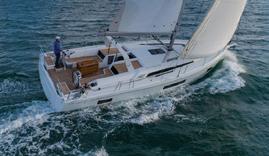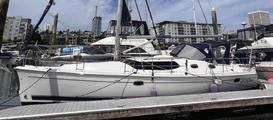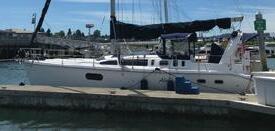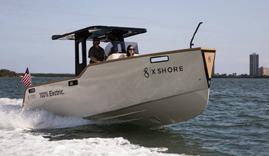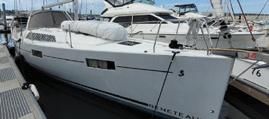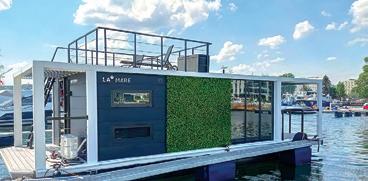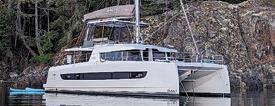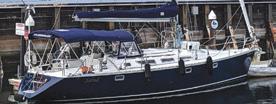





















Marinco Shore Power systems are trusted by serious sailors for one reason: they work. Reliable connections, weatherproof hardware, and proven durability— designed for years of safe, uninterrupted charging at the dock.
When you’re offshore, everything depends on preparation. But at the dock, power should be one less thing to think about. Marinco makes rugged shore power inlets, cords, and accessories built for harsh marine environments— tested by thousands of miles, from Puget Sound to San Diego Bay.
Whether you’re plugged in for the night or prepping for the next leg, Marinco delivers dockside reliability that holds.



32 A Barkley Sound Adventure
New cruisers test their boat and skills with a voyage out the Strait. By Medeea
Popescu
36 Boat Bonding on the Bering Sea
Storm sailing on an Alaskan crossing for the One Ocean crew.
By Jennifer Dalton

SPECIAL Adventure Race Section
With nearly 200 participating boats between them, SEVENTY48 and WA360 offered summer highlights for racers and fans alike.
38 Rowing a Sailboat to Port Townsend
Steak Knives to a Gunfight's historically questionable SEVENTY48.
40 Puget Sound Navigation Company's WA360 Win Savvy sailors rediscover home waters and set a course record.
43 The Adventure We Chose
Team Salish Seasters share stories from their WA360 odyssey.

20 Close to the Water: No Grease, No Glory
Projects to puzzle the neighbors, from trailer hubs to new oars.
By Bruce Bateau
22 Hikes for Boaters: The Broughtons
By
Michael Boyd


Though rewarding, hiking options here are fairly spread out.
24 Necessary or Nice: Bow Thrusters
Is this system cheating, or just smart?
By Julie and Gio Cappelli
28 A Northwest Sailor Navigates the Past

Jolly Roger MacGregor and the pirates of the South Coast.
By Lisa Mighetto
46 Juan-Design Fun at Whidbey Summer Classic
Penn Cove racing at its finest for the San Juan 24s and others.



Sitting among dozens of J/70 racers who had sailed the 26 boats that made up that evening’s fleet, I drank in the fading summer twilight on the lakeside patio. The postrace din held everything from casual conversation to active education, and my attention was soon drawn back to the middle ground of a good-natured deliberation between some longtime sailing pals. I was equally envious of their enthusiasm as I was relieved not to be party to their voyage through contention to consensus. The content of their discussion wasn’t critically important to me that night, but I am intimately familiar with this kind of inquisitive discourse and its unique brand of import—honing the slightest details of set-up, trim, and boat handling; chasing that thousandth-of-a-knot; aching for reliable answers in an environment as inherently complex and dynamic as sailing. Such challenge and commitment, partnership and vulnerability, community and doubt and positive reinforcement—it all makes up the crucible of one-design racing. It’s fun, too, I swear.
Hardly an original idea, but I’ve always thought one-design racing is the best and most fun version of the game, and for me the sportboat sailed by a crew of three to five people is at the mountaintop. The J/70 nestles neatly into that category.
Though one-design has always had my heart, I’ve spent more time in the last decade racing under various handicap scoring systems, learning and experiencing more alongside incredible sailors than I would have thought possible—I count myself extremely lucky. But in part because of what I didn’t find in these recent years, it’s even easier for me to appreciate how valuable it is to sail the exact same boat as your fellow racers. It’s an open invitation to ask, to learn, and to lean into the collaborative camaraderie of competition. It’s possible to find a similar community when racing under a handicap, but in reality it’s just harder. If you’re sailing different boats, the sharing of knowledge often bypasses the directly actionable on its way to the theoretical. That’s part of what makes one-design racing such an accessible learning environment—mastering the processes that make the boat fast paves the way to understanding the principles that animate those mechanics. In essence, you get more enjoyment in the near term while still giving oxygen to the slow burn of deeper knowledge and nuance.
The J/70s have it all right now, boasting big numbers and the panache of some of the region’s most successful sailors. Crucially, though, there are a lot of folks heading out to the same start line on Wednesday nights who are not as accomplished or experienced. Unique to the local J/70s is the role of fleet coach, Ron Rosenberg, whose leadership is not only helping the fleet get up to speed more quickly, but is also fostering a culture of investment in your competitors—like members of the same team. What Ron preaches is special and helps catalyze good practices, but I personally know similar wholesome community vibes are part of many one-design fleets.
None of that positivity precludes the effort, rigor, and desire within a given onedesign team, which brings us back to the table with my pals and their debate about boat handling and trim. I know this may not be everybody’s definition of a perfect evening—sailboat racing’s appeal has its limitations, and other approaches are growing (see the Adventure Racing section, page 38)—but to me it's truly special.
Stepping back into the one-design environment illuminated all the meaning and connection, the knowledge and reward that is available to anyone who joins a fleet like the PNW J/70s. It made me nostalgic for my own history with such communities and the fellowship with those debate-partner friends alongside whom I happily give my free time to solving sailing puzzles, getting faster, and having a legit blast along the way.
I'll see you on the water,
Joe Cline Managing Editor,

Volume XLV, Number 1, August 2025 (206) 789-7350
info@48north.com | www.48north.com
Publisher Northwest Maritime
Managing Editor Joe Cline joe@48north.com
Editor Andy Cross andy@48north.com
Designer Rainier Powers rainier@48north.com
Advertising Sales Ryan Carson ryan@48north.com
Classifieds classads48@48north.com
48° North is published as a project of Northwest Maritime in Port Townsend, WA – a 501(c)3 non-profit organization whose mission is to engage and educate people of all generations in traditional and contemporary maritime life, in a spirit of adventure and discovery.
Northwest Maritime Center: 431 Water St, Port Townsend, WA 98368 (360) 385-3628
48° North encourages letters, photographs, manuscripts, burgees, and bribes. Emailed manuscripts and high quality digital images are best!
We are not responsible for unsolicited materials. Articles express the author’s thoughts and may not reflect the opinions of the magazine. Reprinting in whole or part is expressly forbidden except by permission from the editor.
SUBSCRIPTION OPTIONS FOR 2025
$39/Year For The Magazine
$100/Year For Premium (perks!) www.48north.com/subscribe for details.
Prices vary for international or first class. 48º
Proud members:









48° North has been published by the nonprofit Northwest Maritime since 2018. We are continually amazed and inspired by the important work of our colleagues and organization, and dedicate this page to sharing more about these activities with you.
Maritime High School (MHS), a regional choice public high school in Des Moines, WA, marked a historic milestone in June with the graduation of its inaugural Class of 2025. The ceremony celebrated 31 pioneering students who have become the first graduates of this innovative maritime-focused educational institution.

A collaborative project of Highline Public Schools, Northwest Maritime, Port of Seattle, and the Duwamish River Community Coalition, MHS’s educational approach combines traditional academics with hands-on maritime training, including real-world industry exposure and experiential learning—spanning three mastery-based learning pathways: Marine Science, Vessel Operations, and Marine Construction.
“The first graduating class of Maritime High School shows that the future of maritime for our region is one that will be accessible and inclusive to all of our local communities,” said Port of Seattle Commissioner Ryan Calkins.
Of the 31 graduates that made up the Class of 2025, 25 students completed all four years at Maritime High School, demonstrating the school’s ability to retain and engage students in its specialized maritime curriculum while achieving a remarkable 100% graduation rate.
Among this year’s graduates was Kaylie G., who discovered her passion for vessel operations during her time at MHS. “I plan to attend Seattle Maritime Academy to pursue a career in the maritime industry as an engineer,” she shared. This summer, Kaylie will begin an internship with Washington State Ferries.
Members of the Class of 2025 are set to embark on exciting and diverse paths this fall, with some choosing to enter the workforce directly (equipped with knowledge and credentials to earn $60,000$80,000 per year) and others pursuing higher education at technical colleges and universities—many will continue maritime studies.
MHS’s success comes at a crucial time for the maritime industry, which faces significant workforce shortages—expert estimations suggest the need for 150,000 additional mariners this year.
The Class of 2025 is more than a group of students, it's a symbol of what’s possible when education meets opportunity.
Registration is now open for the 2025-26 school year.
» www.maritime.highlineschools.org



From inspiring presentations to captivating films, from hands-on demonstrations to daily live music—the Port Townsend Wooden Boat Festival is only a month away.
• Kiana Weltzien Brings Women & the Wind: Join Kiana at this year’s Festival for special presentations, a panel on Wharram catamarans, and a screening of the award-winning documentary Women & the Wind.
• Shipwrights: Keepers of the Fleet: Shipwrights from around the world bring the art of boat building to life.
• 76 Days Adrift Documentary: Don’t miss the screening of 76 Days Adrift, an award-winning film based on Steven Callahan’s bestselling book "Adrift: Seventy-Six Days Lost at Sea."
• Ropemakers Return to Festival: The Hardanger Ropemakers from Norway, masters of the ancient art of traditional rope-making, share their expertise all weekend long.
THURSDAY, SEPTEMBER 4
All Day: Festival Boats arriving 5 p.m. Lifetime Achievement Awards
FRIDAY, SEPTEMBER 5
9 a.m. The 2025 Festival officially opens! 4:30 p.m. Keepers of the Fleet: International Shipwrights Panel 7 p.m. 76 Days Adrift Screening
SATURDAY, SEPTEMBER 6
3 p.m. Haida Sails Resurgence Project 6:30 p.m. Women & the Wind Screening, Q&A with Kiana Weltzien
SUNDAY SEPTEMBER 7
11 a.m. Sea Birds with Peter Harrison 3 p.m. Traditional Sail By









A Gold Duck for the Henderson Family’s Vintage Dragon Hey Joe,
Model Shown Beta 38

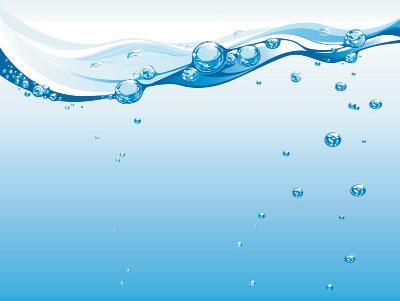
Beta Marine West (Distributor) 400 Harbor Dr, Sausalito, CA 94965 415-332-3507
Pacific Northwest Dealer Network
Emerald Marine Anacortes, WA • 360-293-4161 www.emeraldmarine.com
Oregon Marine Industries Portland, OR • 503-702-0123 info@betamarineoregon.com
Access Marine Seattle, WA • 206-819-2439 info@betamarineengines.com www.betamarineengines.com
Sea Marine Port Townsend, WA • 360-385-4000
info@betamarinepnw.com www.betamarinepnw.com
Deer Harbor Boatworks Deer Harbor, WA • 844-792-2382 customersupport@betamarinenw.com www.betamarinenw.com
Auxiliary Engine 6701 Seaview Ave NW, Seattle WA 98117 206-789-8496 auxiliaryeng@gmail.com

Allan Johnson
Check out this photo taken by the skipper Kris Henderson of his brother Erik on their vintage Dragon US - 10, Sommerfugl. I’ve been sailing with (and against) these guys since the 1980s and this boat has been in their family since the 1970s. She has been sunk, dismasted, and lovingly restored by these shipwrights. Jon “Noj” Henderson built the sails at Doyle New Zealand. Tom Hellmann joined them to help get a gold duck that night.
Response to Lizzy Grim’s Van Isle 360 Report from the July Issue
From Tom Davis on Facebook: Nice write-up, Lizzy! The Van Isle is an epic sailing event, and I have had the privilege of participating in it several times. I thoroughly enjoyed following this year’s event from my armchair... and it brought back great memories.
A Beautiful Ballard Cup Sail!
Hi Joe,
I recently joined a friend’s crew for evening races here in Ballard. I’m a hobbyist photographer, and being on the water at sunset surrounded by so many gorgeous boats and smiling friends, you really can’t ask for a better photo opportunity.
Cheers,
Matt Johnson








T EM B E R
T EM B E R













& 7, 2 02 5










& 7, 2 02 5












©LucSchoonjans 5,6, & 7, 2 02 5


©LucSchoonjans



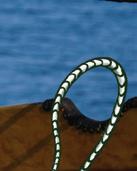


Women & the Wind Special presentations, a Wharram catamaran panel, and a screening of the award-winning documentary Women & the Wind.
Special presentations, a Wharram catamaran panel, and Women & the Wind.
Women & the Wind Special presentations, a Wharram catamaran panel, and a screening of the award-winning documentary Women & the Wind.
Shipwrights: Keepers of the Fleet Shipwrights from around the world gather to showcase craftsmanship and celebrate the art of boatbuilding.
Shipwrights from around the world gather
Shipwrights: Keepers of the Fleet Shipwrights from around the world gather to showcase craftsmanship and celebrate the art of boatbuilding.
76 Days Adrift Documentary Screening of the award-winning film based on a gripping true story of survival and resilience.
Ropemakers Return to Festival Norway’s Hardanger Ropemakers will demo traditional rope-making techniques all weekend long.

76 Days Adrift Documentary Screening of the award-winning film based on a gripping true story of survival and resilience.
Ropemakers Return to Festival Norway’s Hardanger Ropemakers will demo traditional rope-making techniques all weekend long.

Screening of the award-winning film based Norway’s Hardanger Ropemakers will
of Stunning Wooden Boats | Live Music All Day | Craft Beer & Local Food |





and schedule available at Woodenboat.org
|
Tickets and schedule available at Woodenboat.org
|




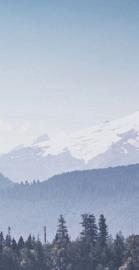



















• Boats
• Kayaks & SUPs
• Trailers
• Gear


• Boat
• Bilge
• Motor
• Live-wells







Fully before moving to a new lake, river, or waterway.

Invasive species such as quagga and zebra mussels threaten our outdoor recreation, economy, infrastructure, environment, and public health. Help stop the spread by cleaning, draining, and drying your gear, equipment, and watercraft every time you leave the water.







Learn more: dfw.wa.gov/ clean-drain-dry

Request this information in an alternative format or language at wdfw.wa.gov/accessibility/requestsaccommodation, 833-885-1012, TTY (711), or CivilRightsTeam@dfw.wa.gov.

If you find a suspected European green crab or their shell, photograph it, note the location, and report it.


wdfw.wa.gov/greencrab
The European green crab is a damaging invasive species that poses a threat to native shellfish and habitat for salmon and many other species. They are not always green and may be orange, red or yellow. These shore crabs are found in less than 25 feet of water often in estuaries, mudflats, and intertidal zones. They are not likely to be caught in deeper water, but may be encountered by beach anglers, waders, clam and oyster harvesters, or those crabbing off docks or piers in shallow areas. As a Prohibited species, it is illegal to possess or transport live European green crabs in Washington. Shellfish growers and private tidelands owners in areas with European green crabs should contact WDFW for management support or permits. Please email at ais@dfw.wa.gov.
Request this information in an alternative format or language at wdfw.wa.gov/accessibility/requests-accommodation, 833-885-1012, TTY (711), or CivilRightsTeam@dfw.wa.gov.
The Fall Boats Afloat Show will be coming to Seattle’s South Lake Union from Thursday, September 11 to Sunday, September 14, spotlighting a world-class fleet of sailing yachts and high performance craft. New for 2025, the show has expanded and now has in-water boats on display at H.C. Henry Piers, directly accessible from inside the main show.
This must-attend show offers a wide variety of boats from the U.S. and Canada in one exquisite location—powerboats, sailboats, day boats, long range cruising yachts—and much more. Show-goers can learn about the latest boating lifestyle and technology trends, and also enjoy a full line-up of curated events while charting their next adventure: live music, delicious beverages, and fun activities for the whole family. A boating tradition since 1978, it is the largest floating boat show in the Pacific Northwest and is presented by the Northwest Yacht Brokers Association (NYBA).
Early Bird tickets are available for purchase on or before August 28, which provide the best discounted prices on Thursday Opening Day, Adult Single Day, and Adult Multi-Day tickets. Teen tickets are not subject to early bird discounts. Children 12 and under are always free!
Standard discounted online ticket prices begin August 29, and are available for purchase through September 14. Skip the lines and get the best prices by purchasing your tickets online.
The Magenta Project has launched the 2×25 global survey, marking the start of the most ambitious equity and inclusion review ever undertaken in sailing and the wider marine industry.
Building on the landmark 2019 Women in Sailing Strategic Review, where 59% of women reported personal discrimination and 80% said gender imbalance was a problem, through this new survey Magenta Project intends to expand the lens to include more research into race, ableism, and age.
Backed by 11 th Hour Racing and supported by World Sailing, 2x25 is led by The Magenta Project, a global initiative committed to equity and inclusion in sailing, in collaboration with a team of researchers and advisors.
Everyone that is involved in sailing and/or the marine industry, all genders and backgrounds, is invited to complete this survey to help build a more inclusive future for the sport.
The survey runs from July to September 2025, with results to be presented in November 2025. Take the survey here: » themagentaproj ect25. qualtrics.com/jfe/form/SV_0VPakFDbA84Ahj8

On-site ticket types can be purchased at full price at the Boats Afloat Show entrance, September 11-14.
• Thursday Opening Day Ticket: $24 (price includes one wine, beer, or non-alcoholic drink at the Breakwater Bar; valid Thursday only)
• Single Day Admission: Adults: $24, Teens (13-17): $7, Children 12 and under are Free!
• Multi Day Admission: Adults: $40, Teens (13-17): $12, Children 12 and Under are Free!
• Discounted Military Tickets available on-site only - must show valid, current military ID, tickets valid for ID holder only. $15 - Adult Single Day Military Ticket.
» www.boatsafloat show.com
American Sailing’s Performance Race Week presented by North U will once again be coming to the Seattle Sailing Club to help refine your racing skills. Held from September 15-19, 2025, seasoned coaches aboard J/80s are there to guide participants through practical onwater training and races, shoreside seminars, and insightful video reviews. The intensive five-day clinic sailed out of Shilshole Bay Marina is designed to elevate your competitive sailing skills, with

special attention given to tactical decision-making. The aim is to help sailors improve their skills in every facet of racing—trim, tactics, boat handling, and driving—and return home a better, more versatile racer. North U coaches combine championship racing skills with years of coaching experience. With just four sailors plus a coach aboard each boat, participants will get close personal attention. And to be clear: The coaches will NOT be sailing the boats. Participants and their teams do all the sailing. The format of each day will vary slightly depending on what skills are being taught and, by the end of the week, sailors are likely to have done more starts than in an entire season of racing at their local clubs.
» americansailing.com
The inaugural edition of the New York Yacht Club International Women’s Championship will take place September 12 to 19, 2026, at the New York Yacht
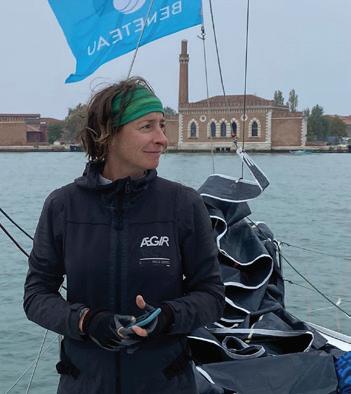
Club Harbour Court in Newport, R.I. The New York Yacht Club recently announced a slate of skippers and teams to contest the inaugural International Women’s Championship next September. Among them is 2023 Rolex Yachtswoman of the Year (and 48° North contributor), Christina Wolfe, leading a team of experienced and talented women from Washington and British Columbia.
Chris Wolfe will be well known to most 48° North readers, if not because of her international acclaim and amazing race results in doublehanded offshore competition here and abroad, then for her articles and interviews in this publication. This newly-formed PNW team includes other accomplished local sailors, including Joy Dahlgren, Jen Morgan Glass, and Maura Dewey. Congratulations to Chris and all of these awesome sailors.
After 25 years of proudly supporting the home boatbuilding community, Duckworks Boat Builders Supply will be closing its warehouse and ceasing operations. This decision has not come easily. Rising costs, increased tariffs, slimmer margins, and increasingly complex shipping logistics have made it unsustainable to continue operating the business at break-even levels. Duckworks is deeply grateful to the customers, designers, and makers who have been part of their journey for the past two and a half decades.
“Duckworks has always been about more than just plans and supplies—it’s been a hub for creativity, craftsmanship, and community,” said Sommer Ueda, VP of Sales & Operations. “We’ve been honored to serve generations of builders around the world.”
While warehouse operations are ending, the Duckworks legacy will continue in a new way. Duckworks founder Chuck Leinweber is working closely with plan designers to establish a new marketplace where customers can continue to access the highquality plans they’ve come to know and love, and more information will be shared as details are finalized.
Gig Harbor Boat Works, Duckworks’ sister company, remains open and committed to building small rowing and sailing craft in Gig Harbor, Washington.
The International Women’s Championship will be an exciting event to follow. We’ll certainly be cheering for this team!
“There is a lot of talent in the Pacific Northwest,” says Wolfe, who has made a name for herself in the doublehanded division of some of the world’s most prestigious ocean races. “The NYYC International Women’s Championship seemed like a great opportunity to pull together an international team for the event. Many of us race against each other in various regattas, but we’ll now have the opportunity to race with each other.”
The regatta will utilize the Club’s fleet of 20 IC37s. The 37-foot keelboat was designed by Mark Mills to a brief developed by the Club. The IC37 is a powerful, sporty platform that rewards cohesive crew work and athleticism. » nyyc.org/2026-womenschamp

The fan favorite Northern Century Race is making a shift in 2025, moving to Labor Day weekend August 29 to September 1. With a reformatted plan for the event this year, the racers reception will be on Friday evening August 29 with live rock music for all featuring Skagit’s own Chill DeVille. Saturday morning will feature a pancake breakfast and then the skippers meeting at 9:30 a.m. The start of the race will be at noon on Saturday.
Racers now have 48 hours to finish (versus 40 hrs in the old format). The Century and the Fifty Cent are still a go, and events and trophies, beer and camaraderie on the lawn will be Monday from 12-3 p.m. This will be a great weekend, and if you’re joining as shore support, Anacortes has a lot of fun things happening Labor Day Weekend. » anacortesyachtclub.com .




























Anchors


by Bryan Henry
The first lightship on the Pacific coast was stationed off the mouth of the Columbia River in 1892.
The first lightship to be moored in the open ocean began operation off Sandy Hook, New Jersey, in 1823.
The first American lightship, then called a “light boat,” was stationed off Willoughby Spit, Virginia, in Chesapeake Bay in 1820.
For its first 15 years of existence, the Statue of Liberty was overseen by the United States Lighthouse Board.
The seven spikes in the crown of the Statue of Liberty stand for the seven continents and seven seas.
The French frigate Isere that transported the Statue of Liberty to New York in 1885 fought rough seas that nearly sank the vessel on its journey.
1 Vessel with two hulls
Area between two headlands perhaps
Resting on or touching the bottom
Rotates as a vessel from side to side
Frozen water
They shelter ships from rough seas
Warrant Officer, abbr.
Football position, abbr.
Narrow passageway used to enter a ship
Sudden powerful forward movement
23 Significant historical period
24 Slang word for a sailor
25 One of the San Juan islands
27 Fastened with a heavy pin
30 Edward, for short
Majestic bird with sharp vision
1 Wear on a line or sail caused by constant rubbing
2 Rocky hill
3 River’s end
4 Object location system
5 Area of sea closely bordered by two pieces of land
6 Seabirds
7 The Northwest ____ : sea lane from the Pacific to the Arctic Ocean
11 Extremely long time period
13 Miles away
14 Planned path of a voyage
16 Fairy tale fiend
18 At sea its often salty
19 Horizon where the sun sets
20 Either end of the yard of a square-rigged ship
22 Rope ladder providing access to the top of the mast
25 Vast body of saltwater
26 Havana is a well-known one
28 Suddenly changes direction
29 Depth of a vessel
Handles (used on radios)
NY time, abbr.
The ninth statute enacted by Congress in 1789 was “An Act for the Establishment of Lighthouses, Beacons, and Buoys,” after passage known as the Lighthouses Act of 1789.
Historians have identified about 30 Roman lighthouses from the Black Sea to the Atlantic Ocean that were built before the empire collapsed in the sixth century.
Among ancient sealife was the saber-toothed herring (Enchodus petrosus).
The oldest known vertebrate was the Anatolepis, a jawless fish that lived more than 500 million years ago.
The earliest known four-legged vertebrate, or tetrapod, was the amphibian Ichthyostega, a descendant of fishes that lived around 375 million years ago.
The Japanese giant spider crab is the world’s largest crustacean and the largest living arthropod.
Once the world's rarest organism, the last living Pinta Island tortoise of the Galapagos known as Lonesome George died in 2012 marking the extinction of his species.
Some species of shrimp live for only several days to 120 days; others can live as long as six years.
Some giant clams on the Great Barrier Reef are more than 120 years old.






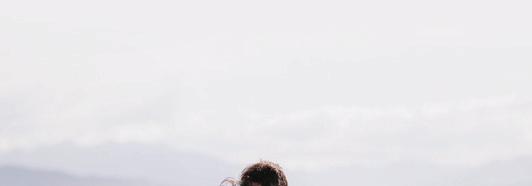








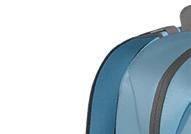





Having a reliable cooler backpack is a must for cruisers going on provisioning trips or simply heading to shore for a picnic with cold food and beverages. The new TravelR Soft Cooler Backpack is a convenient piece of kit that is big enough to carry food and drinks for the crew and comfortable enough to haul on even the longest beer run. The TravelR features water resistant zippers, ColdR™ Tech XPE insulating foam, and a TPUcoated inner liner that keeps the cold in and the sand out. The LoadR Wide Top makes it easy to stock the cooler up with goodies and keep them secure. The backpack has a 24 liter capacity and fits 24 cans comfortably with ice. Color choices include Coral, Charcoal, and South Pacific Blue.
Price: $149.99 » www.rovrproducts.com
Perfect for beachgoers, surfers, dinghy sailors, small boat adventurers, and cruisers with kids and dogs, the Ocean Rise 2.1 gallon Portable Shower is a logical addition to your gear list. Powered by a manual hand pump for effortless pressurized water flow, there are no batteries needed. You can choose from 10 shower head modes, with 2-6 minutes of water run time depending on the mode. The 4mm insulated neoprene cover keeps water warm in winter or cool in summer, while the black tank prevents algae and bacteria growth for cleaner, longer-lasting water. A tangle-free 6.8 foot hose allows it to be hung overhead and a stable base design prevents tipping.
Price: $135 » www.beachsoul.com






















One problem with conventional rope clutches is that there tends to be some amount of slip that occurs when the line is under a heavy load. Spinlock’s new XX range of clutches aims to reduce this issue by holding loads 50% higher than any conventional clutch. Their XX Powerclutches present an ideal solution for genoa and spinnaker halyards on performance yachts in various sizes. Yachts from 35 to 50 feet will choose from the XXA range and for those looking for enhanced performance on small diameter blended covered lines check out the new XXB. Spinlock’s latest jaw technology offers consistent holding of blended covered rope and a smooth controlled release action. The one-piece jaw set is easy to remove and clean and there are access ports for fresh water flushing. The clutches are available in white coated, black anodized, or silver polished alloy to match the deck or rig.
Price: Starting at $625 » www.spinlock.co.uk
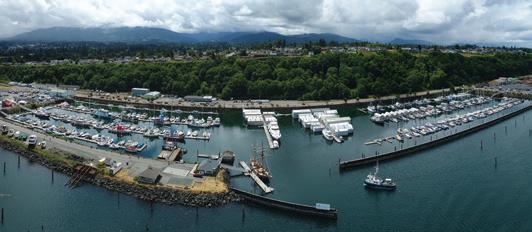












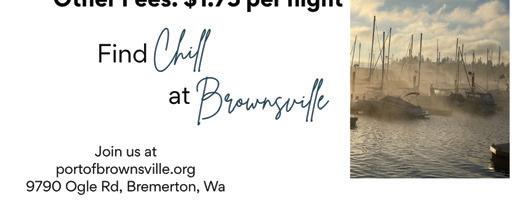

by Bruce Bateau
Aneighbor stares up my driveway and his dubious look says it all, “What’s that boat-obsessed guy up to now?”
Most of my neighbors are used to the myriad projects that happen in my driveway or in the parking spaces in front of my house; either that, or they’re annoyed by the frequent comings and goings of my various craft, and the chores that go with them. With a fleet of small boats, there’s almost always something happening around my backyard boatyard, and I like it that way.
“No grease, no glory!” I call, hoisting a yellow rubber-gloved fist in the air. This particular job could have been offloaded to professionals at my local Les Schwab Tire Center for a hundred bucks and a lot less effort. But unlike diagnosing malfunctioning household appliances or climbing a 40-foot ladder to clean the second story gutters (an activity my wife has forbidden middleaged me from doing) this is a project I can successfully complete.
The gloves are covered in a gloss of blue gray marine grease, as if I’ve just
done surgery on a robot. Which in a way, I have. I’ve jacked up Row Bird’s trailer, unbolted the lug nuts on the wheel, disassembled the hub and bearings hidden below, and cleaned them of last year’s grease. Midway through the process of greasing the bearings and inner workings, I’ve made a substantial, but critical mess. For land-based sailors, keeping our trailer hubs adequately lubricated is crucial—if we omit this task, they’ll overheat and we’ll end up stuck on the side of the highway, smelling scorched metal instead of the tang of low tide. An hour later, the hub is reassembled, the wheels are back on, and the boat is ready to head to points north.
Another day, my quarry is those pesky registration letters required on the bow of most small boats. As an avid sketcher, I’m always doodling bubble letters in my notebook, so I decided that I had the skill to paint my own. Now I’m standing on a six-foot step ladder, paintbrush in hand, trying to create elegant white shapes that resemble letters on Luna’s red sheerstrake. Although I’ve penciled
in each letter and neatly added blue masking tape to avoid unwanted smudges, a friend observing from a lawn chair cheekily informs me that my work is “a little too handmade.”
Climbing down for some perspective, I try to imagine the letters without the blue tape, and I have to admit they aren’t quite as crisp as I wanted them to be. For a moment, I start to wonder if perhaps I should have called a printshop and ordered some of the “nice” vinyl letters so common on boats these days. But in addition to the extra expense, I hesitate to slap machine-made lettering on a wooden boat made primarily by hand.
In the end, I decide to let the paint dry and evaluate. An hour later, surveying my work from 20 feet away, the letters are easily readable, yet still imperfect. But they meet the regulations, and they’re mine. Besides, Luna is already the wooden boat version of a Volkswagen bus; funky letters fit the bill. Another personal project is now complete. Next time I’ll do better.
I approached summer’s last project with a mix of trepidation and excitement. Using a kit, I’d built an ultralight dinghy for Luna, but oars weren’t part of the package. And I’m well aware that a good pair is the difference between rowing being a joy or a torment. The last time I tried making oars I had fun, but ended up with items resembling battle axes, rather than well-balanced rowing


The author presses bearings back into the wheel's hub.












devices. Still, I reasoned that oars for a dinghy didn’t require the skills of a master craftsman. After all, dinghies end up being bashed around at the dock and things in them sometimes go missing. So rather than buying a cheap heavy pair at the marine store, or an expensive, beautiful pair I’d worry about, I decided to make them myself using lumberyard cedar.
After digging through nearly 100 two by fours, I found a handful that were mostly knot free. With the help of a friend, we ran them through a planer

and used epoxy to glue them together to make the shafts of the oars. Over many evenings and weekend afternoons, I employed a band saw, a spokeshave, and a series of planes to turn all that wood into a pair of oars that now moves my dinghy along comfortably. Using them, I remember the joy of seeing something attractive and useful emerge from raw materials.
The completion of the dinghy and oars gave me a sense of accomplishment larger than any of my past nautical projects. But I couldn’t find the words to

describe that feeling until I read a post from my friend Alex at the WoodenBoat Forum.
“There are few opportunities in this increasingly virtual and manufactured world to do something truly authentic, and end up with something unique. To do something that is, to me, a perfect fusion of action and contemplation, of doing and being. To undertake a protracted project that engages your intellect, yet allows you to be in the moment, for extended periods.”
Alex got it exactly right. When I take my boat to a shop, or to someone else for repairs, it’s all out of my hands. Maybe my neighbors don’t get it, but whether I’m doing a simple job on my boat or a more complex task, I’m fully engaged in an activity that feels important, helps me learn new things, or makes me relish skills I’ve developed. That’s nearly as good as being out on the water.
Bruce Bateau sails and rows traditional boats with a modern twist in Portland, Oregon. His stories and adventures can be found at www.terrapintales.wordpress.com


First Fed enthusiastically supports the events, activities, and initiatives of Northwest Maritime through its ongoing sponsorship of the local 501(c)(3) non-profit. First Fed is here for this community in so many ways, and is honored to help uplift others whose endeavors also contribute to the common good!




First Fed helps more people connect with the sea!















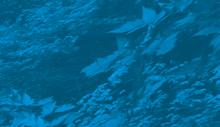
Aby Michael Boyd
h, the Broughtons, one of the dreamiest cruising destinations in the entire region. It is a cruiser’s reward, whether you’ve just challenged often-blustery Johnstone Strait or are ducking in from the bigger water of Queen Charlotte Strait and the Pacific Ocean beyond. This area offers much more than just protection from winds and waves, however—it is a treasure trove of islands and waterways to explore and enjoy.
In this column we are using the Broughtons as shorthand for all the islands, inlets and communities spread out around the south end of Queen Charlotte Strait, not only the specific islands of the Broughton Archipelago. Here, while there are opportunities to get off the boat, including substantial towns on Vancouver Island, real hikes are well spread out. Often, even in marine parks, the only way to get past the beach is to bushwack to nowhere, a strenuous and not very rewarding activity. Still, we have come here enough to have discovered a few favorite opportunities.
The large Vancouver Island town of Port McNeill is our preferred provisioning stop and the private marina is our preferred moorage, mainly because they have long hoses so you can fuel your boat right at your slip. It’s also the closest marina to the laundromat—a real plus since hauling loads of laundry up and down docks is not one of our favorite activities. With a proper supermarket nearby, the essentials of provisioning are taken care of, and if we aren’t walked-out from the chores there are also hikes.
Heading east along the water is a road along a bluff with great views, which after a mile or so leads to a trail near the shore for another mile. This four mile hike has plenty of interest without any appreciable up and down. We’ve done it in both good weather and bad and think it’s gratifying at any time.
But for a lovely hike through the woods from Port McNeill, we have to take a bit of a trip. We catch the BC Ferry to Sointula where we can explore a super nice small town (people offer to give you a ride even if you are just walking along the road) and go for a wilderness hike. Starting at the eastern end of 9th Avenue is the Mateoja Heritage Trail, which goes for several miles through many different terrains, including an area regrowing from a 1923 forest fire, ending at Big Lake. It is easy walking and a very rewarding 4-mile round trip from the trailhead. Of course, you don’t have to come here from Port McNeill by ferry. You can come to Malcolm Island by boat and stay at the Sointula Harbour Marina. The walk to the trailhead is not much longer. We like both options.
Turnbull Cove is a mainland cove at the head of Grappler Sound, across Queen Charlotte Strait from Port McNeill, but you don’t have to expose yourself to open water to get there. Instead, most cruisers get there via a totally sheltered route through the islands of the Broughtons. The cove is a large, landlocked bay with great anchoring everywhere. The hillsides are very steep and show evidence of prior landslides. In fact, a major slide in 2005 ended in the water close to where we had been anchored only a week before. There must have been a substantial tsunami. We prefer anchoring away from steep hillsides now.
This is a marine park and it has a hike. The trailhead is in a small cove on the north side and goes straight up the hill following an old logging road to Huaskin Lake where there is a ramp from shore out to a float; it even has a picnic table. It’s only half a mile but the road is slowly becoming overgrown and the trail gets harder every year. From the float you can only see a small portion of the lake but its arms extend many miles in several directions. It would be fun to kayak the lake, though hauling the kayak up there from the cove, less so. We’ve seen bear tracks on the trail and in 2023 a black bear was walking the rocks along the shoreline near our boat when we got back from our hike. As with most hikes it's important to be bear-aware.
Logging roads are a good way to stretch your legs, if not always the most desirable hikes. Some were recently in active use so they aren’t as pretty, since trees haven’t filled in yet, but that also means they may offer expansive views. The best access is usually at the old log dump, which is often close to some good, or at least adequate, anchorage. Here are some we have used. There are many others we have seen from the water but haven’t visited. New ones come along regularly, of course; an active logging site today may be an interesting hike in some future year.
A black bear turns over rocks near Mischief in Turnbull Cove. Hikers in this area are advised to be bear aware.

Opposite the entrance to Potts Lagoon on the north side of West Cracroft Island is a fairly recent logging road. We were there just after it was abandoned and there were lots of signs of bear activity.
In the Warren Islands at the entrance to Call Inlet is a logging area that closed down just prior to our visit in 2022. From the top of the road there was a spectacular view of Havannah Channel and surrounding area. The bad news: when they abandoned the site they cut deep swales across the road every 100 feet all the way to the top. It was for drainage, presumably, but it made hiking challenging; walk 100 feet, climb down 5 feet of loose rock, climb up 5 feet on the other side then repeat. It felt like we covered three times the distance and it was just as hard going down.
Close to the entrance to Roaringhole Rapids, near Turnbull Cove, is a new log dump with a fairly good road going up the hill and then north towards Nepah Lagoon. There are some excellent views and not too many deep swales cut into the road. As it heads north it joins older logging roads with more woods. We anchored in Turnbull Cove and rowed the dinghy to the log dump. It’s about a mile from the boat.
Many of the marinas in this area, including Port Harvey, Kwatsi Bay, Shawl Bay, and Greenway Sound have all closed in recent years. From the Jennis Bay Marina site on the north shore of Drury Inlet you can access a number of logging roads that provide excellent hiking opportunities. There is excellent anchoring in the bay if the marina is unavailable.
In 2023, we saw active logging in Greenway Sound near the old marina site, in Tsakonu Cove on the south shore of Knight Inlet and at the south entrance to Sargeaunt Passage. Make a note, in a few more years there may be hiking opportunities here as well.
Unlike the more developed hiking opportunities farther south, hiking in the Broughtons is often an exercise in exploration and discovery; we wouldn’t have it any other way.
Michael and Karen have been cruising the Salish Sea and beyond for more than 20 years, hiking every chance they get. For more resources for hikers visit their website at https://mvmischief.com/library/




The wind was up, the slip was tight, and the peanut gallery of marina neighbors had assumed their usual spots. Perched in cockpits, coffee mugs in hand, performing their silent critiques. As I backed into the narrow berth, a friendly nod came from a guy two slips down, the kind that says, “Nice job, skipper.” For a moment, I basked in the pride of a maneuver well executed. Then the unmistakable whir of the bow thruster echoed off the dock pilings. The nod became a knowing smirk. Pride gave way to sheepishness. Well, so much for impressing the locals.
Bow thrusters have become a flashpoint in the ongoing debate over seamanship,
technology, and what it means to “really” know your boat. Some sailors consider them a vital docking tool, the mark of a practical skipper who values control and safety. Others dismiss them as crutches; something that erodes boat-handling skills and cushions you from learning how your vessel truly moves. So, are they necessary? Or just nice?
To answer that, we have to begin with what they are. A bow thruster is a small propeller mounted near the front of a boat, typically in a tunnel running athwartships (sideways) through the hull, on an external pod, or in a retractable unit. It allows the bow to push port or starboard independently of the main engine or
by Gio and Julie Cappelli
rudder, making tight maneuvers much easier. They’re especially useful at slow speeds where most sailboats become sluggish or unpredictable, particularly in reverse. On some boats, especially those longer than 40 feet, have dual rudders, or with substantial freeboard, bow thrusters are included as standard equipment. But even on smaller vessels, retrofitting one has become a popular upgrade among coastal cruisers, liveaboards, and aging skippers who want to ease the strain of docking in dicey conditions.
There is a reason why cruisers of all kinds love them. Few chores spike your heart rate faster than docking in a stiff crosswind with current running and only
The farther forward a bow thruster is installed, the better rotation you'll have when using it.
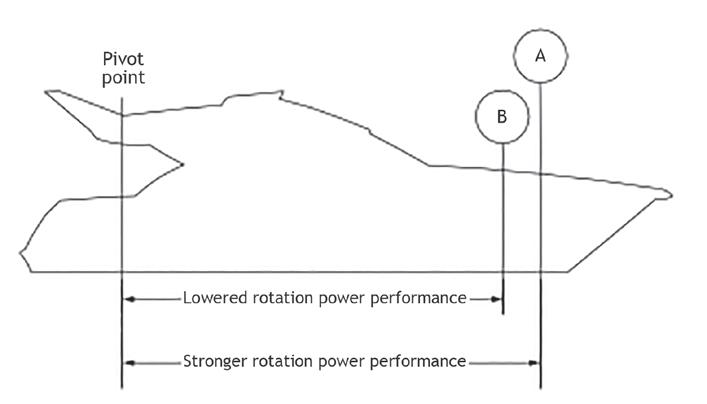
six inches between your toerail and someone’s sparkling topsides. A bow thruster offers an escape hatch from that particular flavor of panic. It lets you correct a blown approach or counteract windage with the push of a button. When your crewmate is stepping off with a dock line, or when you’re alone at the helm trying to lasso a piling, having lateral control over the bow can prevent a whole host of mishaps—not to mention bruised egos.
For shorthanded crews or solo sailors, it can mean the difference between taking the boat out or staying within the safety of a slip. Owners can install a remotecontrol system in tandem with their controls at the helm that activate the thruster’s solenoid electronically. These remotes allow the operator to control the bow thruster from virtually anywhere on the boat, adding a valuable layer of versatility and convenience, especially when docking or maneuvering solo.
In crowded marinas or popular anchorages where space is tight and slips are narrow, bow thrusters can reduce the stress of threading the needle. They’re especially helpful on boats that catch the wind or water and complicate precise movements—those with high topsides, full keels, center cockpits, or tall rigs. On most production boats, they can only counteract wind forces up to about 20 to 25 knots, and many seasoned sailors acknowledge that docking a long, heavy vessel in close quarters requires a different skill set than sailing. In these
situations, a bow thruster can make a big boat feel smaller, nimbler, and far more forgiving.
A bow thruster can also be an invaluable asset during a soft grounding. Sea Otter Cove is one of the northernmost anchorages on the west side of Vancouver Island—beautiful and well-protected. However, its entrance channel is shallow, narrow, unmarked, and constantly shifting. Last summer during an early morning departure, our keel gently found the mud as the boat came to a slow stop in the shallows. With careful use of reverse coupled with the side-to-side maneuvering power of the bow thruster, we were able to wiggle free and get back underway with no drama.
Still, bow thrusters come with tradeoffs; starting with cost. Factory-installed units on new boats can easily add several thousand dollars to the price tag. Retrofitting a thruster into an existing hull is an even bigger undertaking. It requires hauling the boat, cutting a custom hole in the bow, glassing in a tunnel, running heavy-gauge wiring to a dedicated battery bank, and installing the control systems. A client of ours recently added a tunnel-style bow thruster to a 45-foot sailboat, with the total cost topping $14,000. The price can climb even higher if your boat requires a retractable thruster, or if installation is complicated by limited access or components, like a freshwater tank beneath a V-berth that must be relocated.
Another downside of bow thrusters is


their significant energy demand. Electric bow thrusters draw substantial power and their consumption increases with thrust capacity. Thrusters are typically rated by the amount of lateral force they produce (usually in kilograms) and by their corresponding power draw. Simply put, more thrust requires more energy. To see just how demanding these systems can be, we partnered with Skagit Valley College’s Marine Maintenance Technology Center in Anacortes. Using state-of-theart multimeters, we tested a 100 kg-rated bow thruster in operation. Our amp clamp recorded an inrush current spike of 1,231 amps at 12V DC, before quickly settling to the manufacturer’s nominal rating of 740 amps.
This highlights the need for properly sized and well-maintained battery banks, wiring, and connections. You’ll need to account for that in your electrical system planning. Some owners go so far as to add a separate battery bank forward to minimize voltage drops or sluggish thruster performance. On top of that, maintenance can be a recurring headache—especially in saltwater environments. Corrosion, maintaining zincs, marine growth, and motor failures aren’t uncommon, and most repairs require a haul out.
Modern hull designs favor flatter bottoms and shallower drafts near the bow. This makes it difficult to install a tunnel thruster far enough forward of the boat’s main pivot point for good leverage or deep enough to avoid cavitation.




A well installed bow thruster motor will have a protective barrier between its housing and electrical connections and loose items in the locker.



















Retractable bow thrusters offer a solution to this challenge. A retractable bow thruster is a motorized propeller unit that folds up into the hull when not in use and is lowered into position when needed. Retractable bow thrusters allow for their installation to be farther forward, providing greater leverage, improved thrust and reduced drag, since the thruster remains enclosed within the hull when not in use. This is an especially valuable feature for racing yachts. However, retractable thrusters come with a larger price tag and require proper maintenance, as they can become jammed by marine fouling when neglected.
Perhaps the most overlooked drawback, though, is a subtle one: the potential erosion of boat-handling skills. It’s easy to let the thruster become a first resort instead of a backup tool. I’ve watched skippers hit the joystick before even checking wind direction or thinking through a spring line maneuver. When that becomes the habit, situational awareness and seamanship start to suffer. And if the thruster fails, which is a possibility each time it is used, you’re left reacting instead of handling.
Full keel or heavy displacement boats are another case. Many traditional cruisers track beautifully offshore but handle like shopping carts at low speed. Add a narrow marina fairway and some tidal flow, and things get complicated fast. I’ve been at the helm of one such boat during a docking attempt in a tight Pacific Northwest harbor, with a brisk











crosswind and an engine idle setting that surged just enough to foil any finesse. The rudder was useless, the reverse was sluggish, and the bow had a mind of its own. That was the day I truly understood the appeal of a bow thruster.
For those without a thruster—or for those who prefer not to rely on one— there are plenty of effective alternatives. Understanding how your boat behaves in reverse, especially in terms of prop walk, can turn what seems like a quirk into an asset. Strategic use of spring lines can let you pivot, pull in, or back out of a slip with surprising elegance. Even the timing of your throttle, the angle of approach, and how you use your momentum all play a role in fine-tuned handling. Some boats are even equipped with stern thrusters, which—while less common—can offer more nuanced control, especially on wide transoms. And of course, no substitute exists for a well-briefed crew. Good communication and practiced line-handling will always trump buttonpushing when things go sideways.
So, what’s the final verdict?
For newer skippers learning to handle a boat in crowded conditions, a bow thruster can be a powerful tool. Nice, certainly, but in many cases approaching necessary. For those with limited mobility, small crews, or a tendency to dock in challenging spots, it becomes an even more attractive asset. For skilled sailors who take pride in traditional handling techniques and enjoy the challenge of tight quarters, a bow thruster is still just nice. Something




This bow thruster needs some serious maintenance. Biological fouling can cause increased cavitation and deteriorated zincs can lead to galvanic corrosion.

to appreciate when it’s there, but not something you’d miss.
For us, a bow thruster remains squarely on the nice list. The price tag associated with the installation of a new bow thruster, for most, is extremely prohibitive. You can buy a small but capable near shore sailboat for the price of a bow thruster installation! Prudent seamanship means always having a plan A and plans B, C, or even D when it comes to docking. Success lies in recognizing the variables at play during each docking situation and preparing corresponding strategies in advance. Equally important is truly understanding how your boat handles. Dedicated sessions to hone close-quarters maneuvering, learning to use prop walk to your advantage, and practicing various approach techniques is time well spent, and often the difference between a smooth landing and a catastrophic one.
If you’ve got a bow thruster, there’s no shame in using it. And if you don’t, enjoy the quiet satisfaction of gliding gently into that slip without it—until you’re wedging into the last available space in Ganges with 15 knots on the beam and a boatload of witnesses.
Gio and Julie of Pelagic Blue lead offshore sail training expeditions and teach cruising skills classes aimed at preparing aspiring cruisers for safe, selfsufficient cruising on their own boats. Details and sailing schedule can be found at www.pelagicbluecruising.com.











Become a part of the 48° North crew! In addition to your magazine each month, with this exciting new subscription offering, you’ll also be supporting 48° North in a more meaningful way. But, warmed cockles are far from the only benefit. Others include:
• Annual subscription to 48° North delivered to your door.
• Two 3-day pass to Port Townsend Wooden Boat Festival ($110 value)
• Northwest Maritime Center Member decal
• 10% discount on most items in the Welcome Center
• $100/year (additional fees for First Class forwarding or International)
THE
PLEASE: Our standard subscription gets you 12 months of 48° North and its associated special publications (SARC, Setting Sail, and the Official R2AK Program).
• $39/year (additional fees for First Class forwarding or International)



Business or Pleasure, AquaDrive will make your boat smoother, quieter and vibration free.

The AquaDrive system solves a problem nearly a century old; the fact that marine engines are installed on soft engine mounts and attached almost rigidly to the propeller shaft.
The very logic of AquaDrive is inescapable. An engine that is vibrating
on soft mounts needs total freedom of movement from its propshaft if noise and vibration are not to be transmitted to the hull. The AquaDrive provides just this freedom of movement. Tests proved that the AquaDrive with its softer engine mountings can reduce vibration by 95% and structure borne noise by 50% or more. For information, call Drivelines NW today.


by Lisa Mighetto
At first glance, Roger MacGregor comes across as every bit the engineer. He has a reserved, pragmatic personality focused on building things. When I met him at his home in Newport Beach, California this spring, he quickly moved the conversation from introductions and pleasantries to describing the architectural features of his house, which sits on a dock overlooking the busy harbor.
“This was a one-story building when I moved here,” he explained, pointing to the upper level he had added himself. After spending several days with Roger, I also saw an artistic, fun side that—at age 90—still gets caught up in the joy of being on the water while relishing aesthetic details. He designed the decorative stained glass that lines the railing of his wharf, for instance, and his 70-foot boat Anthem was recently named one of the “most beautiful sailboats of all time” by Sail Universe, the culmination of a career that began when he built his first vessel, Jolly Roger, at age seven. While Jolly Roger was a wooden rowboat, MacGregor recognized the potential of fiberglass early on, eventually outlasting his competition and engaging thousands of first-time boat owners.
During those sunny spring days, Newport Beach seemed a world away from my home waters in the Salish Sea. Yet MacGregor boats have a solid presence in the Pacific Northwest, extending Roger’s influence far beyond Southern California. His story provides a glimpse into an industry and lifestyle that evolved rapidly during the late twentieth century, transforming recreational sailing.
THE “FLAMING NUTHOUSE” OF COMPETITIVE BOAT DESIGN
California’s South Coast, located between Los Angeles and San Diego, is as alluring as a postcard, characterized by bluegreen water, golden sand, and tall palms swaying in warm breezes. Its surfing culture, borrowed from Hawaii after World
War II, adds to the charm. Yet this region also became an industrial powerhouse during the post-war period, with steel mills, auto assembly plants, and shipyards. The aerospace industry flourished here in the 1940s, thanks to the availability of a skilled workforce, universities that spurred research, and land. Roger, who was born in Pennsylvania and grew up in Ohio, moved with his parents to Southern California in 1948, joining the great post-war migration of residents from the Midwest and East Coast to the Golden State. He studied economics at Occidental College, where he met his wife Mary Lou, and after several years in the Air Force entered business school at Stanford University.
Here he began the project that would become MacGregor Yachts. “We had a couple of kids by then,” Roger explained, “and we wanted a boat where we could be reasonably comfortable and wouldn’t sink… and there weren’t any.” One centerboard sailboat he considered “would fall over just looking at it.” Wooden boats were heavy and had to be moored, which could be expensive. So the goal of his business school project was to design an affordable, unsinkable, trailerable boat that a family could use. After Stanford, MacGregor worked for Ford Motor


Co.’s Aeronutronic Missile and Space Division, where he was able to observe “Henry Ford’s original concept of a production line.” In 1964 he started his own boatbuilding business in Costa Mesa, up the hill from Newport Beach, while still employed at Ford. His new company’s first vessel was the West Wind, which Mary Lou, who was very much engaged in the business, described as “ugly as sin and fast as smoke.” When the number of employees reached eight, Roger left Ford, and by the mid1960s, MacGregor Yachts was off and running.
Many of Roger’s neighbors had the same idea. Estimates claim that 70 to 100 marine companies operated in Costa Mesa, which became the center of boatbuilding in the late twentieth century (Bradley Zint, “New Exhibit Tells ‘The Hull Story’ of Costa Mesa’s Boatbuilding Past,” Los Angeles Times, May 4, 2018). Sailboat companies operating along the South Coast included Catalina, Columbia, Cal, Ericson, Islander, Hobie, and others.
“It was a flaming nuthouse” of competing businesses, Roger recalled. “My street had probably 20 boatbuilders on it, and you couldn’t go anywhere without running into a truck hauling a boat or resin tanks” used to make fiberglass. They were “turning out thousands of boats. It was just unbelievable.” At lunchtime during the 1960s and 1970s, local restaurants filled with boatbuilders clutching drawings and financial plans, with “all the necessities of the industry spread all over the place.” Attracting employees was easy. “I’d put a sign out and 50 people came in,” he remembered. Keeping them was a different story, as rival companies lured workers away.
The proximity of all these businesses made the challenges of establishing a new company more immediate and more personal. “It’s one thing to compete with a company in a distant part of the country,” Roger commented. “It is quite another to compete with one across the street or just over the fence.” In the days before cyber espionage, Costa Mesa spies were lowtech, sometimes peering through fences and into the windows of rival operations. “What one company learned was captured by another in a matter of days, if not hours,” he marveled. Those who could not keep up were left behind. “It is the sailboat’s equivalent to Silicon Valley, only more concentrated.”
Listening to Roger talk about the early days in Costa Mesa reminded me of a movie from the late 1990s called “The Pirates of Silicon Valley,” about the cutthroat rivalry between Apple and Microsoft in the early days of personal computers

and information technology. As “pirates,” Steve Jobs and Bill Gates brought innovation, explosive growth, and, some would say, an aggressive, fierce culture to their companies. These entrepreneurs flourished because they seized opportunities, and they were at the right place at the right time.
The competition in Costa Mesa and along the South Coast quickly fueled improvements and efficiencies. Fiberglass, for example, presented boatbuilders with exciting possibilities, and MacGregor Yachts embraced the new technology. This glass-reinforced plastic, invented in the late 1940s, encouraged aerodynamic designs and monolithic hull construction. Unlike wood, fiberglass resists rot and leaks, making it ideal for boat construction and maintenance. By the 1960s and 1970s, it had become the dominant material in boatbuilding.
“Fiberglass could create incredibly complex curved surfaces,” Roger explained, “providing the designer with complete freedom regarding styling.” Aesthetically, MacGregor preferred a modern appearance with sleek lines, asserting that “the new fiberglass boats were far better looking than the wooden boats that they replaced.” While that is a matter of endless debate, fiberglass offered an unbeatable advantage: it was affordable, allowing thousands of new boat owners to enter a market that had previously excluded them.
Another way Roger kept costs down was to implement workstations geared toward specific tasks, patterned after Ford Company assembly lines. “That was my advantage,” he explained. “Each station had all of its tools, jigs and fixtures, parts, diagrams, and samples.” In fact, he designed boats with workstations in mind, expecting that each component would be assembled independently. This approach reduced the need for skilled labor, making production more efficient and less expensive. In contrast, other companies adopted a traditional approach, with the same skilled employees handling all sections of boat construction. Catalina was an example, and MacGregor spent some time in Los Angeles with owner Frank Butler observing his production techniques, concluding that he preferred his own workstations.
Roger described Butler as an “excellent boatbuilder,” someone he respected and admired. “I would rather take on General Motors as a competitor,” he commented, than “a motivated




individual entrepreneur, such as Frank Butler of Catalina or Jack Jensen of Cal Boats. With family-owned businesses, their money, egos, and pride are on the line,” driving a desire to succeed and “flatten the competition.”
Perhaps Roger saw himself in the entrepreneurs surrounding him. The social scene gave him ample opportunity to mingle with rivals, as every Friday night they met together at a local bar for “Boat Dealers’ Balls.” Emotions ran high, and these gatherings sometimes ended in brawls and fistfights. “It looked like the Wild West,” he mused, remembering the unbridled exuberance and lack of restrictions. There was camaraderie, too, as boat dealers sponsored football and baseball leagues and formed lasting friendships.
During the 1970s, Roger became pals with a fellow entrepreneur who shared a dream of building a company that would bring sailing to the masses: Hobart “Hobie” Laidlaw Alter. Inspired by the surfing culture at Laguna Beach, Hobie began building 9-foot balsa wood boards for his friends in the 1950s, eventually opening a surf shop in Dana Point. As a champion surfer, he helped revolutionize the surfboard industry by introducing polyurethane foam boards, which were lighter and faster than the old wooden boards. By the 1960s, his focus had shifted to catamarans patterned after Polynesian twin-hulled vessels. The introduction of the Hobie Cat 14—light, affordable, and easy to use—helped set a new sailing culture in motion. Hobie organized regattas, fostering camaraderie and competition among racers, many of whom were new to sailing. Later in his life Hobie moved to Orcas Island, but in the formative years of the 1960s and 1970s he was a legendary figure in Southern California.
MacGregor Yachts sold close to 50,000 boats, including catamarans, 65- and 70-foot racing yachts, and sailboats ranging from 19 to 26 feet. Roger attributes much of his success to boat dealers who helped with transporting, outfitting, and sales. He had dealers all over the world, but none sold more boats than Todd and Cheryl McChesney of Blue Water Yachts in Seattle.
Cheryl bought a MacGregor Sailboat in the late 1980s after seeing an ad in 48° North. While she had grown up boating in the Salish Sea with her family, this was the first vessel she had purchased. “Hey, I can get a boat,” she realized when she saw the price. “And I could trailer it, too,” eliminating the need for moorage. She later married Todd, who had sold her the boat.


Together, the couple devoted the next three decades to introducing many first-time buyers to the joys of boating. Cheryl guessed that as many as 75 percent of their customers were new to sailing, while the “rest were experienced sailors who were downsizing for easier handling or to trailer to lakes and farther destinations.”
Blue Water Yachts brought nearly 1,000 MacGregor sailboats to Pacific Northwest waters. “It’s the perfect boat for this location,” Cheryl explained. “With the distances you can cover under motor, you can actually get to places you couldn’t before.” And while many are content to explore the protected waters of the Salish Sea, some MacGregors have circumnavigated Vancouver Island and ventured to Alaska.
“We were fairly close,” Roger recalled of his neighbor. “Hobie was kind of my idol for a long time because he got a big business started.” One of the most memorable results of their friendship was a massive gathering of employees from Hobie’s company and MacGregor Yachts on the beach at Crystal Cove. Nearly 500 people attended the party, which included music blasting from a sound system on the bluff overlooking the sea, while participants roasted pigs in the sand. Caught up in the revelry, some of the employees fought over the food, eventually toppling the sound truck and sending it crashing to the beach below. “What a day,” Roger commented, remembering the arrival of the authorities who warned him, “you gotta stop this craziness.” Roger and Hobie were ordered to clean up the beach. “It was epic,” Roger concluded.
After talking with Roger, I visited Crystal Cove, now a state park, and tried to imagine the wild scene decades earlier. All I saw were quiet couples walking on a lovely beach, with pelicans soaring overhead and a few terns and seagulls running along the sand. It was a different era.
The McChesneys offered sailing lessons to all customers who wanted them. “We made the boats easy to sail from the cockpit,” Cheryl commented, and “we had the best instructor, Ray Copin, retired USCG Captain and aviator, who was himself a MacGregor owner.”
From the outset, the couple organized gatherings, including concerts, barbecues, and seminars, where MacGregor owners could socialize and learn more about their boats. Their annual MacGregor Rendezvous grew out of a Friday Harbor event they co-sponsored in the early 1990s with 48° North, called the “Plastic Fantastic Fiberglass Boat Festival,” a spoof on the Port Townsend Wooden Boat Festival. “There were lots of MacGregors there,” Cheryl remembered. “We made a grand entrance sailing together past the ferry dock to join the festival.” Today, the MacGregor Yacht Club of British Columbia continues the tradition of providing an annual rendezvous and an online space where owners can share cruising and maintenance tips.
By the early 2000s, most of the boat builders along the South Coast of California had closed shop or relocated. Environmental regulations, rising property values, and encroaching population increased the costs of operating in Costa Mesa, fragmenting the concentration of businesses that had spurred the innovation
and productivity of the past. MacGregor operated longer than many of his competitors, stopping production in 2014 when a retirement home emerged on the border of his plant. Although awareness of the toxicity of resin fumes was not widespread in the 1960s, by 2014 the business and regulatory environments had changed.
Blue Water Yachts continues to ship MacGregor parts to boat owners all over the world, a testament to how widespread MacGregor sailboats remain. Cheryl marvels at the far-flung destinations she never expected to find boats, wondering, “Really, they have water there?” Todd reports that the most remote location for a MacGregor sailboat may be Spitsbergen Island in the Svalbard Archipelago, about 600 miles north of the Arctic Circle, where he recently shipped a cockpit enclosure. He joked that the added protection would extend the owner’s sailing season “from three to six weeks.”
“Should we go sailing?” Roger asked on our last day together. Off we went to board Anthem, the second version of his “most beautiful” 70-foot boat. The breezy, sunny day in March could have passed for summer in Seattle. We backed away from the dock to enter a bustling harbor, weaving through a fleet of electric Duffy boats, various crews, power vessels of all sizes and shapes, and a few sailboats. We raised two of the five sails while still in the harbor. As our boat shot forward and heeled 20 degrees, I nervously glanced at the boats all around us. But as soon as we sailed out of the harbor on a reach, Anthem easily hit her stride and I relaxed, realizing that not only had Roger designed and built the boat, he had won the Newport Ensenada Race three times. We were in the best hands, and I sat mesmerized as we sped down the coast. Roger looked as content as I had seen him, clearly in his element. And I thought this is what it’s all about—getting people on the water, sharing the greatest sport and lifestyle the West Coast has to offer.
Lisa Mighetto and her husband Frank have sailed the Salish Sea in Murrelet, their MacGregor 26X, for 25 years, including a trip to the west side of Vancouver Island. She is grateful to Roger and Mary Lou MacGregor, Todd and Cheryl McChesney, and the Costa Mesa Historical Society for information and photos.




The author's MacGregor 26X
Vancouver Island’s Cape Scott is not a patch of water to be trifled with. Days of gales gave way to light breeze and sunny skies and we bounced along under sail, equal parts exhilarated and terrified. Suddenly, a dark shape surfaced off the starboard bow. A humpback! Practically eye-to-eye, we stood dumbstruck by the sublimity of the scene, watching its tail flukes disappear beneath the waves. That evening, we anchored in Quatsino Sound, not a soul around for miles. Otherworldly howls came from shore—the wolves several cruisers reported in the area. We pulled up another full crab pot, and couldn’t think of a place we’d rather be.
This was one of the most memorable journeys Frank and I have taken in Murrelet, our MacGregor 26x. Living in Seattle, we had only two weeks of vacation and could not afford to charter a boat. How did we pull this off? We trailered our boat to Port Hardy and took out a few days later at Coal Harbour. Conventional sailboats in Seattle traveled for weeks to reach the same destination.
Trailering a 26-foot boat is not for the faint-hearted, it’s a different skill set from sailing. Yet our boat’s trailerability has provided access to many cruising grounds we otherwise could not explore. And our 50-hp outboard allows speeds up to 20 knots, depending on the weight in the boat and whether the water ballast tanks are full.
Frank and I named Murrelet after a Northwest seabird, which, despite its small chunky body, is a fast flier, often seen streaking across the water. Murrelets nest on land, sometimes miles inland, reminding us of a trailerable MacGregor. We have devoted many hours searching for wildlife in our boat, often bringing friends and Audubon Society members along. Our retractable centerboard allows us to venture into shallow areas. Sure, we could do this in kayaks, but our MacGregor gets us and our guests home before dark.
by Medeea Popescu

The engine’s bass vibrations rumbled below me as I laid on the teak planks of the cockpit. The sun was out, the dodger blocked our apparent wind, and I was taking the opportunity to sunbathe in the late spring calm after many blustery and overcast days. Motoring our way west out of the Strait of Juan De Fuca, we’d just spent a rolly night at anchor in Thrasher Cove, the last protected anchorage on southern Vancouver Island before hitting
the mouth of the Strait.
Our destination was Barkley Sound or as far as we could make it—maybe the outer Broken Group or possibly all the way into Ucluelet if we had enough daylight. It was early June and the days were long, but our Nicholson 32, Aeoli, is not a speedster. She is a solid 1960s fiberglass boat with a full keel and 13,000 pounds of lead ballast. We were happy to be chugging along at around four knots against a slight
incoming tide and the long, smooth rollers pushing their way in off the ocean. We estimated that the 40 mile trip would take us at least 12 hours.
NOAA and the Canadian Weather Service told us to expect light and variable winds in the morning, with the breeze picking up through the afternoon. Using the motor is unusual for us. As new boat owners— one of us (me) a complete novice, and the other drawing on teenage experience lake
The islands of the Broken Group in Barkley Sound where the authors found shelter after a long transit.




sailing—we’re stubborn about pushing ourselves to stick to sails as much as possible. That approach had made for some very slow spring sailing around the San Juan Islands, as we found ourselves in wind holes, just a mile from some harbor entrance that was tantalizingly out of reach.
On this particular morning, we caved and fired up our little-used engine. We hadn’t learned to trust it yet, and maybe we shouldn’t ever get too comfortable. Every time we turn it on I worry that it’ll sputter out of breath and leave us drifting, pulled along by the powerful tides muscling along this rocky shoreline.
We’d taken our time exploring the Gulf Islands and spent several days in the unexpectedly wonderful Becher Bay, east of Sooke, hiking many miles of the regional park abutting the anchorage. Our decent weather was about to run out, though, and we’d found ourselves in a bit of a time crunch. A late-season atmospheric river was forecast to hit the coast the following


Tucked into the anchorage after a long day sailing out of the Strait.
day and we wanted to make it to Ucluelet for the brunt of the rain. Without a heater or shower on board, the pull of comforts at the marina was strong.
Every time we passed through a patch of wind, ripples gaining definition in the smooth blue expanse around us, I turned to Victor and asked, “Should we try sailing?” We pondered the question for a few minutes, squinting at the waves, sticking our heads over the side decks, trying to feel the difference between our apparent wind and the longed-for afternoon breeze. I knew that we should be grateful for the smooth trip down the Strait due to cautionary tales from fellow cruisers and notes in our old copy of the Waggoner guide, but it’s just plain boring sitting around burning diesel to get somewhere.
After two false starts—pulling the jib out, shifting into neutral, watching the sail fill lazily then collapse—we finally had enough wind to move us along at two to three knots. The rest of the afternoon
passed while the intensely green shoreline slowly slid past. We spotted whales diving and surfacing, close enough to smell their fishy sighs and blows. The clouds began to blot out the sun and it soon became time to put on thermal layers and drysuits again. We could see the grey wall of fog looming ahead of us, marking the end of the protected waters of the Strait. By this point, it was nearly 5 p.m. and we still hadn’t made it even with Cape Beale, which marks the southern extent of Barkley Sound. I was getting a little nervous as the waves rolling past us began to build. This was our first trip outside of the protected waters of Puget Sound, and neither of us knew what to expect.
Soon, we hit the wall of fog and were running nearly blind, with only the waves coming towards us visible—we weren’t sure if we’d be able to see the winking light of the Cape Beale lighthouse in the soup. Trusting our old Garmin chartplotter and the backup downloaded nautical charts
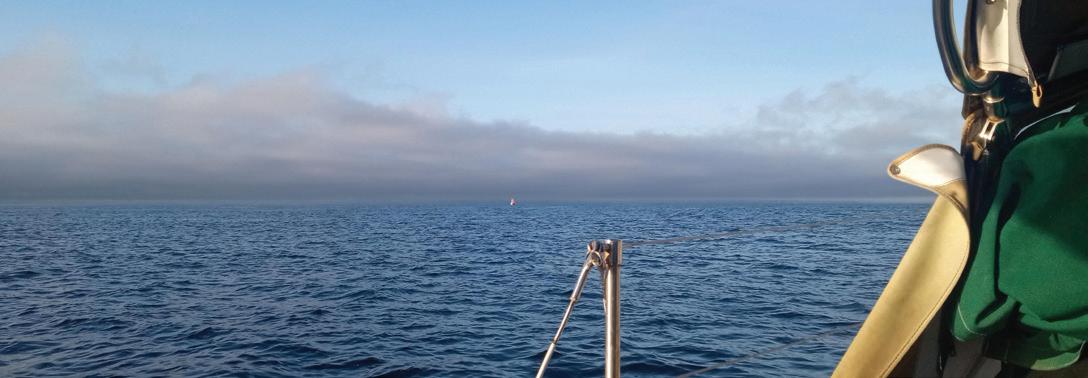

on our phone, we surged ahead in the building wind from the port bow quarter. The cruising guide warned us about the many reefs, rocks, and rips in the area, and we kept about two miles offshore. It was clearly going to be too late to make it into Ucluelet before darkness fell.
Accordingly, we decided to drop the hook in an anchorage tucked between Wouwer and Howell islands, part of the Pacific Rim National Reserve’s Broken Group. You enter the anchorage through a 500-foot gap between two tree-topped rocky outcroppings, and is described as having enough room for just one boat, with bow and stern anchor being preferable.
The slot we aimed for came into view as we sailed northeast towards the sound and it turned out to be about 200-feet wide, and was being pounded by swell breaking spectacularly against jagged rocks. Both of us were on high alert, aware that this is probably the riskiest thing we’ve tried so far on our little boat. We readied to drop the sails and Victor went on deck to muscle the mainsail in against wind now pushing 15 knots and gusting higher. At the tiller, I was alternating between neutral and giving it a bit of power to keep us moving to avoid the reefs. I was sweating under my GoreTex drysuit despite the biting wind and cold, and I could tell Victor was nervous too from the way his voice tensed as we yelled to communicate over the wind and waves. We decided to switch places, and I moved up to the bow to direct us through the slot and into the anchorage. “A little to port!”
“Now forward! More forward! Keep
going forward!”
We chugged forward between the breakers, entering the surprisingly calm inlet. I could see where a reef was exposed ahead of us and to either side. Still getting the hang of positioning us in anchorages, this little gunkhole presented a good challenge. We dropped the anchor with what we thought was enough swing room and hunched nervously in the cockpit for another fifteen minutes despite our fatigue, watching Aeoli right herself into the wind. It’s a beautiful spot, remote and weather-beaten. Deciding that we were ok, we finally went down below, windweary and wiped, stripped out of the drysuits, and got into our sleeping bags after a half-hearted canned dinner.
The next morning, our plan was to make the crossing over to Ucluelet and pull up at the small craft harbor for a few days. We didn’t have cell service, so there was
no way to call the harbormaster ahead of time to ask for specifics about how to dock and where to berth. The handheld VHF radio that we use as a backup doesn’t have the best range, either, so we weren’t counting on being able to hail anyone. “How hard could it be?” we figured. The wind carried us across the northern half of Barkley Sound to the tip of the Ucluth Peninsula, where we dropped the sails and fired up the engine for the slow chug up the narrow inlet leading to Ucluelet. I scanned the shoreline as Victor maneuvered us through the channel markers, trying to guess which of the many docks, pilings, and little inlets might be the small craft marina. “Maybe that one?” I guessed after we passed what looked like the commercial fueling docks, some private resort-looking docks, and we had nearly reached the end of the buoy-marked stretch of this little


waterway. Taking our last option, we made a blind dogleg turn to port that was lined with rusting fishing boats. Victor spun Aeoli around slowly in a wide circle and we motored slowly around the bend. A jumble of masts came into view, with sailboats and powerboats leaning into the docks and into each other in this tightly packed little harbor.
I thought there should theoretically be a fuel dock where we could tie up, but I had a sinking feeling we must have already passed it. The depth was dropping at what was now low tide, and the rafted-up boats made the fairways disconcertingly narrow. In desperation, we decided to just raft up where we could and deal with moving after talking to the harbormaster. As we brought Aeoli around the finger docks, another couple happened to be aboard their boat and I yelled out, “Where should we dock?”
“Just raft up to someone with fenders out!” they replied.
“Thank you!” I called back.
We found an algae-streaked Catalina with many fenders lining its lifelines and tried our hand at our first raftingup experience. It took some nervous maneuvering and hasty fender-tying, but soon we were secured—as well as we could be—to our new neighbor. Luckily, it didn’t look like anyone had been on the boat for quite a while, so we didn’t feel too weird about clambering over the side decks to get to the dock.
We found the wharfinger, Kevin, just arriving at his office at the head of the dock. He welcomed us to Ucluelet and we paid the shockingly low weekly rate, planning on hunkering down until the storm had passed. Ukee, as the locals call it, is the perfect size for exploring without a car. The harbor is right in town,

there’s a small but excellent grocery store, and a few restaurants and coffee shops offer a bit of variety. On top of that, there are lots of outdoor activities—bike rentals for the coastal path that winds up to Tofino, hiking all along the shoreline of the Ucluth Peninsula at the western edge of town (our offline maps helped us navigate the network of trails in the pouring rain), as well as protected surfing along the coast. You could (and we did) spend many days here.
The Wild Pacific Trail winds for about 8 km, moving into dense coastal Sitka spruce forest and out onto wind- and wave-battered rocky outcrops. A few side trails lead down to tiny pocket beaches and, at the very end, we walked around the Amphitrite Lighthouse, which has been guiding boats into Barkley Sound since 1915. By the end of our few days in Ucluelet, we’d walked this stretch of coast many times, but it never got old: the heaving sea, shifting sky, wheeling birds, and changing light kept it new every time.
When the storm finally passed, we’d stocked up on affordable Canadian food and had done our laundry in the coinoperated machines at the harbor. We stuck our nose out of the inlet to see if it was doable to cross back into the Broken Group for a few days of island hopping. The forecast called for lingering three to four meter seas, but we were going a bit stir-crazy and were ready to move again. We didn’t know what that sea state would feel like, but figured we’d give it a shot and see how we could handle it. (We could, which is a story for another day.)
Still learning the limits of our skills and of Aeoli, getting to this point had felt like a great adventure—and we were ready for more!
Victor and Medeea bought their first boat, Aeoli, in the winter of 2023 with the goal of going cruising full-time that summer. Together, they taught themselves to sail in the waters of Puget Sound and Canada’s Gulf Islands, explored up Vancouver Island’s west coast, and took their time working down the coast to Baja California. After a winter cruising the Sea of Cortez, they’re back in the Pacific Northwest ready to welcome a new addition to their crew! Aeoli is patiently waiting in Mexico for their return in a few months.

The Anacortes-based crew of the custom Perry-designed 48foot sailboat, One Ocean, is now several months into their expedition to circumnavigate the “One Island” of North and South America. Led by Captain Mark Schrader and Project Director (and author of this article) Jennifer Dalton, they’re presently in Nome, Alaska, waiting on an ice window to begin their eastbound transit of the Northwest Passage. All along the way, the voyage balances research and education—with several scientists aboard who are working with professional researchers ashore to gather data that helps better illuminate ocean health and challenges. The crew then actively shares this info as well as stories of their adventures, connecting and educating communities and students far and wide. What follows is an excellent sea story about their passage to Nome. Learn more at: www.oneislandoneocean.com .
by Jennifer Dalton
ark and I were on the 6 a.m. watch. I hadn’t slept much. The gale-force storm we’d been tracking had arrived. From my bunk, I listened as the waves intensified, crashing violently against the hull. On this tack, my bunk was on the high side and my body was held in place by a lee cloth. Though monitored closely using Windy and Ventusky, the realities of a storm always unfold with some unique personality, and this one was increasing in strength at a time that coincided with my upcoming watch.




I climbed out of bed with the ease of a drunken sailor, the boat tossing me around the cabin as it rode the waves. In the main saloon, sailor/scientist Mike and Outreach Director Tess were alert and focused, wrapping up their 2 a.m. to 6 a.m. watch. They briefed Mark and me on the conditions. Mike referred to the 25-knot winds as “sporty.” They’d already reefed the headsail before the wind picked up, and the main and mizzen sails were both double-reefed. One Ocean was ready, thanks to my crewmates. Mike and Tess retreated to their bunks, and I began making our morning coffee. That’s when the autopilot was suddenly overpowered by wind and waves. The boat spun up into the swell, and instantaneously the view through the windows turned white—a massive wave had engulfed us, pounding and churning us out of control. One Ocean has two helm stations—one inside the pilothouse and the other in the cockpit—and Mark tried to reset the

autopilot from the protected pilothouse helm, but it wouldn’t hold.
Mark stayed at the inside helm while I clipped my harness to the dodger and climbed into the cockpit to take over the more responsive outside helm. As I got One Ocean back under control, huge waves crashed into the cockpit through the open sides of our dodger enclosure and, combined with sideways rain, I was soaked in seconds. It was only 41 degrees outside, and the Bering Sea water temperature was just 39 degrees—confirmed by the Applied Physics Lab’s data monitor. I was woefully underdressed: fleece sweater, salopettes, rain boots and life jacket—nothing more. The waves towered 18–20 feet, and I could hear each one roaring up behind me.
Mark soon came out in full foul weather gear to relieve me so I could suit up properly. My hands were frozen, my entire back sodden. I handed over the helm just as One Ocean caught a wave and surfed down it, white foam breaking all around. Mark turned to me and said, “Next time we decide to save the planet, we fly.”
For the next six hours, we traded shifts at the helm until calmer conditions would allow us to employ the autopilot once again.
I had been intimidated by the Bering Sea, and I suppose I was right to be. Before leaving Dutch Harbor, the crew, like always, reviewed multiple forecasts. We compared at least three different weather models across various apps. Two showed the storm missing us; one predicted we’d ride a strong 20 to 25 knot southerly.
We decided to go, but not without preparation. I followed Mark as he inspected every inch of One Ocean. His eye for detail, for safety, and for crew comfort came from years of experience. I trusted that. Still, I was respectfully nervous. I pulled him aside after our meeting and asked quietly, “Are we sure this is a good idea?” The Bering Sea was unknown territory for me.
He listened. We triple-checked weather
models, added a second reef in both the main and mizzen before our departure (both of which we happily utilized mid-gale), and ensured everything was lashed down. He felt confident in the boat, the crew, and our preparation.
When we left Dutch Harbor, the sun was shining. The sea was calm. The Bering Sea felt less intimidating than I’d expected. That day of sailing in fair conditions helped. Whatever my wavering emotions before the crossing, when I took the helm during the gale, I wasn’t afraid. I felt steady. I felt ready.
Mark had been training me for a moment like this. Over the past few years, I’ve been an eager student, learning from this Jedi-master of sailing. I was grateful he was there, but also proud that my instincts, preparation, and training were solid. I was relying on those skills more than I was relying on him. When he returned to the cockpit, layered up and warm, I was grinning. He laughed, pulled out his phone, and took a video. “You’re a natural,” he said.
I grew up sailing and windsurfing. Out there, in that wild storm on the Bering Sea, it came back to me. I could feel the waves through my feet, anticipate the swell, and surf the boat with confidence. I was in my element. I wasn’t just keeping control, I was sailing this amazing boat in epic conditions across one of the world’s most beautifully remote and rugged patches of water.
Mark said I handled it exceptionally well. Coming from him, that meant everything.
I’ve always felt connected to One Ocean, but now, I feel bonded to her on another level. I know I still have so much to learn—any sailor does. Every moment at sea brings new lessons. Mark has taught me so much, and some days it’s overwhelming, but I’m grateful for every bit of it.
We’ve only just begun our 27,000 nautical mile journey, and already we’ve faced serious crossings. As we head farther north, the next challenge awaits: navigating ice. And lucky for me, I know just the guy who can teach me about that too.
Jennifer Dalton is the Project Director and crew for the Around the Americas sailing and research expedition that departed Anacortes, Washington in May 2025. The expedition is conducting the first ever pole-to-pole bull and giant kelp study and sharing findings through an open online education platform. www.oneislandoneocean.com




by Jake Beattie
“We do these things, not because they are easy but because they are hard.”- JFK
Sure, JFK might have been talking about putting a man on the moon, but we put an Olson 30 on the dock in Port Townsend after 70 human powered miles from Tacoma. In the midnight haze of deeply fatigued divination, we can’t be sure that JFK’s ghost wasn’t there as we crossed the finish line to declare, “Them too.”
Which gets us to the “What the hell is he even talking about?” part of the article. Here are the facts:
SEVENTY48 is a human powered race that launched over 100 teams out of Tacoma’s Foss Waterway in early June. Destination: Port Townsend, some 70 miles north.
Of the teams that started, only 72 finished before the race’s 48 hour time limit.
One of those finishing teams consisted of 11 souls on a jerry rigged Olson 30; pedaling, rowing, and towing it with a kayak.

This is the story of that team, Team Steak Knives to a Gunfight, and their improbable bid for glory through aspirational mediocrity.
I first heard about the team when it was just chatter at last year's at last year’s Race to Alaska’s Blazer Party. A group of R2AK ir/regulars had come up with a seductively horrible idea: take a boat that should in no way do a human powered race, pack it to the gills with 11 people and a questionably large sock monkey, don’t prepare, don’t practice, then try to make said Olson 30 go an average of 1.5 knots for 48 hours. Why? Because… dumb.
My exact words were: “That’s the worst idea I have ever heard. There’s no way you’re doing this without me.” In that moment, I barged my way into the best bad idea since the Race to Alaska. Others soon joined, and over the next nine months, Team Steak Knives to a Gunfight slowly grew from a threebeer-enthusiasm to an actual thing. That evolution only got real for me as I pedaled off the dock just before the start in Tacoma. “Jesus, we’re actually doing this.” 3, 2, 1… go.
“If we had eggs, we could have bacon and eggs, if we had bacon.” - Anon
The S/V Wildfire is an Olson 30, two times R2AK finisher as Teams Monkeyfist (‘23) and Natural Disaster (‘24). It already had a twin prop pedal drive, not to mention solar power, and a complete sail inventory—perfect for the WA360’s engineless but mixed propulsion challenge and technically compliant though outlandishly impractical for a race that prohibits sailing. Augmenting the proven pedal drives were two rowing stations thrown together out of dimensional lumber and deconstructed
rowing machines. Cherry on top of this dog turd of an idea: a pedal kayak to tow from out front.
Wildfire’s mast was left on the dock to reduce windage, a SeaBQ was mounted to the bow pulpit to increase it. Why? Because steaks. Predicted boat speed: 1.5 knots.
“Men wanted for hazardous journey. Low wages, bitter cold, long hours of complete darkness. Safe return doubtful. Honour and recognition in event of success.” - E. Shackleton
There were 11 onboard; 12 for those who count the sock monkey (I don’t). The crew were R2AK elite (four first place finishes, 6-plus additional finishes) a 26-year-old rower-adventure racer we imported from the UK, and me; a guy who has only ever written about this stuff. Some of us had met each other, all of us had never met at once until the starting line. No training, no practice, no test runs. What could go wrong? Surprisingly, not much.
Q: What did the snail say while riding on the turtle?
A: “Whee!!”
If you love rooting for which paint will dry faster, you would’ve been on the edge of your seat for our crawl up the west side of Puget Sound.
We had anticipated 1.5 knots. Out of the blocks, with fresh horses, zero wind, and calm water we high fived ourselves until our palms hurt at our actual boat speed: a blistering 2.4. Blistering, both for our expectations of speed and for the actual blisters that formed on our no training hands after hours on the oars;
and on our butts after hours sitting at our makeshift pedal stations.
We looked, frankly, ridiculous. Tiny yellow kayak puddle ducking away 50 feet off the bow, sawed off sailboat with four people churning water from the ass end, a prominent yet dormant BBQ on the bow. Despite the ridiculousness, 11 people rotating through 5 propulsion stations turned out to be pretty effective. We kept going, we got some sleep, someone could always make food.
The weather was hot, but benevolent. The headwinds were light and short lived, and there were only two times when being anchored was the fastest we could go—once waiting out wind off of Kingston, once waiting out current in the Port Townsend Canal. Our program was designed around continuous movement. Even with cramped/friendly/consensual sleeping arrangements, only six could sleep below decks. Pit stops left roughly half the crew (including the sock monkey) fighting over the big spoon on whatever flat spot they could find on deck.
Remarkably, impossibly, we finished at 0348 Sunday; 13 hours to spare and setting the unconfirmed but undisputed record for rowing an Olson 30 from Tacoma to Port Townsend. Three to five people clapped, 11 more were justifiably self-impressed. I lost the $20 I bet against us even finishing. Hilariously, 21 teams finished after us. That’s gonna need therapy for sure.
“You can drive a car with your feet if you want to, but that don’t make it a good idea.”- Chris Rock
I’m writing this 48 hours after our 4 a.m. finish. The blisters on my hands are subsiding, the blisters on my ass remain;

and the swollen, deep red sunburn on the topsides of my feet continue to remind onlookers of the leftover hotdogs still rolling at midnight at your local 7-11. Since we hit the beach I’ve been pounding Gatorade like it was water, water like it was cocaine, and just now starting to feel my dehydrated kidneys going from a raisin-like state to something closer to prune hands. I’ve slept more in the past 6 hours than I did the whole weekend.
Did I enjoy it? Absolutely.
The race was a rare respite from life’s noise, where I was immersed in a singular purpose: get there. For 35 hours I poured every ounce of muscle and physical endurance into getting the team’s 6,000odd pounds to Port Townsend, then collapsed for 36 hours, then staggered for another 12.
In adult lives, it’s a rare opportunity when you get to drop everything and test your limits; leave it all on the field. For most of us, at some point the wild infinity of life funnels into a fog of routine punctuated by birthday sex and parent teacher conferences. For me, the race was a chance to break free of life’s metronome and immerse in something simultaneously incredible and ridiculous, all while connecting with another 10 people (no, not the sock monkey) who were doing the same; forming a once in a lifetime community we’ll remember for the rest of our days. It was like summer camp for adults, if summer camp replaced archery with punishment.
I have never worked so hard to go so slowly. It was the worst kind of impressive. Am I glad I did it? Yes. Would I do it again? Hard maybe, but maybe you should try. Registration opens November 15th.
A fuller race recap and many more details can be found at: seventy48.com


by Joe Cline
eam Puget Sound Navigation Company, composed of Molly and Michael Karas and Anthony Boscolo, won the WA360 adventure race and smashed the course record with an elapsed time of 2 days, 18 hours, and 24 minutes. Anthony and Michael each are R2AK steak knife winners from 2016's Team Jungle Kitty. Puget Sound Navigation Company sailed the Karas’s Gougeon 32, Incognito, which they purchased from fellow Port Townsender, Russell Brown (who set the solo R2AK record on the boat in 2018). Molly, Michael, and Anthony were gracious enough to sit down with 48° North for an interview after their victory.
Who was the lead instigator on this team? And how did it all come together?
Michael: I think it was Molly.
Molly: I was bummed I couldn’t do R2AK when they did it. I pushed for getting a Gougeon 32 with the thought that it would be a cool boat to do one of these races on. Something we could race and get where we wanted to quickly, but you could still cruise it. As we narrowed in on the Gougeon, Russell [Brown] started helping us look for one. Eventually, he said, “I’m going to work on my next boat project, and I’m ready to sell.” Luckily, by that time we had our daughter Mara and that was a big draw for Russell—to have family in the boat. Once we got this boat, we were like, “Well, it already has a pedal drive, so…”
What about the prospect of jumping into a lengthy adventure race excited you—Anthony and Michael to pursue it for the first time since R2AK, Molly to do it for the first time?
Michael: The timing was right. We knew a lot of the waterway already.
Anthony: Your cell phone works most of the time. The safety net is there.
Molly: We have a toddler. It was very doable for us to just hop in, take off a few days from work, and the logistics were easy— we left from home and we came back to home. So, why not do this race? It’s kind of dumb not to. It’s like a little vacation. There’s no energy to think about anything else for a few days. And I was stoked to hang out with these guys and have a break from toddler life.
Michael: We all really trust each other in sailing, and we know our levels are fairly comparable. Maximizing the boat’s potential, that focus and trying to see what you can do is fun for me.
Anthony: I have really fond memories of Race to Alaska. There’s this special feeling with these events that Northwest Maritime puts on, and the fact that there’s people tracking you, and you’re sailing by random houses and people holler at you. It just feels comfortable and interesting, and you also feel kind of like a star when someone shows up in a powerboat to interview you. The community gets around the event, it’s very different from your everyday weekend racing event. That vibe is so unique, and it makes it really special and fun.
Molly: Among the competitors, too. What race do you go to
and everyone is cheering on all the other race boats? You’re crossing paths constantly because you have to do 180s, and you cheer for your competitors, or even ask for help.
Did you have a lot of time in the boat before the race?
Molly: Anthony had been on it cruising for a cocktail cruise only twice before the start! He had less than two hours on the boat before WA360.
Anthony: I had more time working on the pedal drive than sailing the boat before WA360.
Molly: We’ve done some little cruises with Mara, and Race to the Straits two years in a row.
After lead changes through the first day, you pulled away at night. What happened?
Molly: Yeah, it was pretty challenging that night. We were fighting hard currents.
Michael: And no wind.
Molly: At one point, Narrows Minded passed us at like 5 knots and we were literally standing still—it looked like they were motoring, silent, they had some super secret sail up. We started pedal sailing with this tiny little zephyr of wind, and caught them after a couple of hours. I went to bed and the boys pedaled really hard. We were able to round the Olympia mark first and have good current for like an hour and legged out before it switched again.
Anthony: That leg down to the shoal when Mike and I were up, we were close-hauled with a zephyr of breeze with our big screecher, trucking down there.
Michael: Trucking being a relative term. There was another section on the way back up when Molly and I were pedal sailing too. We had a super straight run for a mile and a half, and I’m pretty sure that was a very fast section for us, going like 4 knots.
What portion of the race were you just pedaling, versus pedal sailing, versus just sailing?
Molly: We did about 24 hours in the pedals. Of that, there were at least 15 hours that was just pedaling. Anthony: I did some rough math, and we did close to 60 miles with the pedal drive in the water.
Molly: And all of that was against current. I don’t think we pedaled with the current, ever.
How would you describe the level of effort on the pedals?
Molly: If someone is pedaling and we were not sailing, then someone was paddling too. We could go 4.5 knots for a very short time; that was our high effort top speed. Otherwise, the guys were faster pedaling and could sustain 3 knots.
Michael: If someone was paddling or if you were sailing, it just reduced the load on your legs.
Anthony: There were times when we had to rotate out of pedaling because we were exhausted, and then there were times when we were casually pedaling—like in the Swinomish Channel, we had to go a long way. I was still definitely sweating, still in my underwear in the middle of the night, but not at my limit.
Molly: We were so gross (laughing).
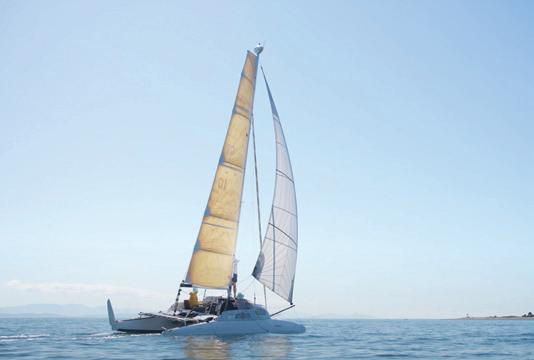
Unlocking an upwind mode with the screecher was a game changer in light air.
by Garret Weintrob.
Tell us about your watch schedule. Was it rigid or flexible?
Molly: We started four hours on, two hours off. Toward the afternoon of the second day, we were all getting pretty tired so we changed it to three hours off to try to get more sleep. At that point, the boys had about two hours of sleep each, and I had maybe four hours. There was a lot of resting, but there wasn’t a lot of sleep. You’ve been exercising and sweating, and then you’re just supposed to go to sleep? Switching to three hours helped.
On the last night, it turned out to be pretty windy and gusty in the San Juans. In the Gougeon, that can be pretty peppy, so you want to see the puff. At night, you can’t see it coming. There’s a very fine tipping point between we’re heeled and we’re capsized. It was pretty stressful. After that stretch, Mike laid down in his drysuit and life jacket on the spinnaker and just passed out and slept for three hours. He came up, Anthony went down and slept like the dead. So they each got a little sleep at the very end, and finished the race with maybe 6 hours total. I think we were still functioning, but we were tired. If we had gone one more day, I think we all would have started sleeping really well.
Any long race with a lot of physical effort, you’re going to have some lows. When were you feeling low, and how did you push through?
Anthony: I was feeling bad for Michael because he had this terrible cough.
Michael: I woke up sick on Thursday and was questioning if we could race, but by Saturday morning's start I was ok.
Anthony: But that was my low moment, feeling bad for him and wondering, “Is this going to work with Molly and I getting around this course with Michael’s dead weight?”
Molly: My only low in the race was when Narrows Minded went past us in the South Sound. That was like, “Man, this isn’t going to happen.” But we just kept pedaling and paddling. We were exercising so hard, I never felt tired at any point the first two nights, which is weird. I was waiting to feel exhausted, but didn’t get tired until the last night. I had fun the whole time, minus that little bit.
Anthony: I was a relatively late addition to the team, and I was really in this just for the fun. I wanted to go do this R2AKstyle adventure. And I was really into the idea of getting to go
Puget Sound Navigation Company sailed brilliantly, but their adventure experience was definitely Type-II fun with more than a third of their time utilizing human power in light air and adverse current.
Photo
by Jim Meyers.

sail the Gougeon and tweak around with it, because it’s such a quirky little boat. I knew this was going to be a blast! I didn’t really think we were in it to win it, especially after walking the dock and seeing a few of the racecars out there. On the first day going down the Sound, the Seacart passed us like we were stopped. From a racing perspective, I was like, “Ok, I’m going to check that emotion off the list. We’re going to try hard, we’re going to have a good time, but we’re probably not fighting for the win.” After a while when they got stuck on the bottom side of Vashon for a long time, my mentality was in-between whether to be emotionally attached to trying to win or just having a good time—and it was actually kind of a nice place to be. I stayed pretty high the whole time.
Michael: I had a few lows, because I was so exhausted from being sick, especially the last hour of my watches throughout. I probably didn’t eat as much as I normally do and it’s really energy driven for me. And when I’m really tired, I lose confidence in sailing and things like that.
Molly: I don’t think any of us were like, “We’ve got this!” at any point in the race. Until we could see Port Townsend. But after watching Broderna get swept out to sea in the first WA360… anything can happen.
What did you learn about your boat over the course of this race?
Molly: Anthony taught us about a secret upwind mode, you can sail upwind with the screecher. It saved our race.
Anthony: I mostly figured this out from the Russell Brown trimaran that Haley and I bought last year, and it has a screecher that’s really similar to the one that’s on the Gougeon. When it’s super light, you need some more sail area to get it going. Messing with halyard tension and trimming the screecher really hard works, and I was curious to see if it would work on the Gougeon too. You can take it pretty much close-hauled—maybe a couple of degrees off, but way faster.
Molly: The pole on the Gougeon can go anywhere, it’s got unlimited range. It’s hard to replicate settings, but what we found to work was pull down as hard as you could on the leeward side and tighten the pole there, and then tighten the luff of the sail.
Michael: Basically adjusting the sheeting angle by adjusting where the tack is.
Molly: That was what we did from Lummi all the way to Point
Roberts in our magical super straight layline going mach 10 on glassy water.
Anthony: That was good sailing.
What did you learn about the Sound?
Molly: I’d never been so many places, that was really cool. Never done the Swinomish and come out the Bellingham route. Never been to Point Roberts. Never gone under the Narrows.
Anthony: I learned that the stereotypes are real, they just got reinforced for me. Like the South Sound—everyone knows there’s no wind down there, and there’s no wind down there. The current is all over the place, and you gotta watch out for it.
Michael: We were very cognizant of the currents. There were some really interesting forecasts that didn’t pan out. It got so windy in Colvos on the way back up, I’ve never seen it so windy there. And it was totally unexpected. Probably 20-25 knots.
Anthony: There’s some interesting little microclimate things going on. If you lived there you’d know, “Oh the breeze always blows from that direction,” or whatever. Just passing through, I don’t know if it’s a regular thing or not, like we sailed in a weird east breeze off of Whidbey that forecasts weren’t calling for. You’ve got to keep your eyes up, don’t always trust the models.
Molly: Even though there was no wind a lot of the time, it was a really pretty time to be doing this. The moonsets were really early, there were stars every night. The sunrises every morning were insane. Even though the coastline is really different between the South Sound, the inside of Whidbey, the Swinomish is really different, Point Roberts, the San Juans— everyone along the way is one big community, cheering for us and sending us support. Everything is really connected.
Any other lasting highlights?
Molly: It was so cool how much cheering there was on shore.
Michael: Random encounters in the middle of the night.
Molly: People would be waving flashlights at us in their houses at night so we know that they’re cheering. We got binoculars out more for looking at shore to see what people were yelling at us than anything else. For me, it was just taking it in, and realizing we’re doing this really cool race and we have all these people supporting us, and we’re doing it with a bunch of crazy people who think that Type-II fun is a good thing. The paddle crews really like Type-II fun. Boogie Barge… they are machines! Or anybody that did it solo. We gained a lot of appreciation for what Russell did on this boat in Race to Alaska. Because we live here, we were able to bring our daughter down and cheer on a few teams at the finish.
Anthony: That’s also a fond memory from Race to Alaska. In Ketchikan, you’re going down to greet and cheer teams at the finish, and then go get a beer afterward. This reminded me of that. It’s really fun to welcome others and hear their stories.
Molly: I wanted to go back out again, I thought we did it too fast, we missed out on the fun of the longer adventure. We also missed out on some gnarly conditions, we had it easy. The teams that finished behind us had some hard decisions to make—a bunch of gale warnings, multiple days in a row. I mean, it was fun to do it fast too.
For full results: wa360.org

by Stephanie Campbell
WA360 is a Northwest Maritime adventure race with a distance of approximately 360 miles; but you certainly sail more than that, and I’m sure it feels like 3,600 if you’re doing it under human power alone. I was sailing on a Santa Cruz 27 as part of Team Salish Seasters, homeported in Bellingham—a sailing community that sent six teams to WA360, several of whom we interacted with quite a lot during our race.
The race starts in Port Townsend and sends racers through the Narrows to round Olympia Shoal before heading back north to Goat Island on the south end of the Swinomish Channel. You can take Swinomish Channel or you can cut through Deception Pass on your way north, both equally nail-biting because of strong currents and narrow passages. From there, it’s mostly open water—up to Bellingham Bay, over Point Roberts, and back to Port Townsend with lots of navigational options through or around the San Juan Islands.
The 83 participating boats were literally of all shapes and sizes driven by racers of all ages—from 8 to well… surely older than me. There are two main divisions, human power (Muscles) and boats with sails (Wind). Most of the human powered boats were very small, many singlehanded—paddleboards and kayaks, rowboats and ocean rowboats, as well as the breathtakingly creative homebuilt pedal catamaran called Boogie Barge that led the way amongst the Muscles. In the wind power category, the fleet ranged widely too with mono- and multihulls galore and 30-foot race boats sharing the course with tiny gaff-rigged row-sail craft. Almost every sailboat had some form of human power as well— pedal drives, oars and paddles, and Bill and Darlene Stange’s Westsail 32 Hula launched their dinghy to tow themselves through the light spots (imagine doing it in that boat, married to the person in the dinghy).
With good breeze for the majority of the race, the multihull sailboats definitely had a speed advantage over the rest of the fleet. Some fully crewed boats raced day and night, finishing in just a few days, while the smaller boats

and crews camped each night and took the entire two weeks to complete the journey. There is more than one way to experience the event—all with unique potential for pain and fabulousness.
Each of the four of us on Team Salish Seasters has a sailboat of our own. Our trusty ride for the WA360 was the Santa Cruz 27 Wild Card, which has completed the Race to Alaska twice and attempted the inaugural WA360 in 2021. One of us Salish Seasters, Katie Gaut, raced Wild Card in the 2024 R2AK with Team Sail Like a Mother and has a lot of sailing miles under her keel. Our crew also included Wild Card’s new owner Melanie, as well as Karen—both with deep backgrounds as adventurers on river rafts and sea kayaks. I was the only sailboat “racer” on board, per se, and my racing terminology kept everyone entertained. WA360 isn’t a traditional sailboat race by any stretch, and everyone contributed in their own way.
Some teams were far more prepared than others, and we were probably “well enough” prepared—somewhere
between the well-oiled machines in the front and our buddies on Team Wild Unos on a Wilderness 30 who survived on Wheat Thins while using three sails purchased for $300 on Craigslist right before the race. Spoiler alert, they beat us to the finish!
After a community breakfast at Northwest Maritime, all 83 boats started together in a slight, but sailable northerly. We Seasters were about two minutes away from the middle of the line with about a minute to go when I remembered that we could pedal. With that extra knot of speed we were just about on time in the middle of the line. Boats that wanted to take the outside of Marrowstone owned the boat end of the line and turned upwind. We took the inside route. Southbound boats hoisted kites along with some pedaling here and there, but it was an easy passage under the bridge in the Port Townsend Canal and out to Puget Sound.
For a while, the conditions and shorter distance favored the inside boats, but eventually wind filled on the outside

and it all evened out. It was a great kite run down the Sound, and the only big decision was inside or outside Vashon. It appeared that there might be more breeze outside but ultimately it was just a greater distance and it didn’t pan out.
We arrived at Tacoma Narrows as it was getting dark. It was a bit intimidating to pass through at night in a decent breeze with the kite up and in close quarters with Team Wild Unos. After wrangling the kite to the deck we heard a power boat approach in the dark calling out “Wooohoo Salish Seasters!” We thought that the media boat might want to discuss our sail handling skills, but instead a friend had been following us on the tracker and found us out in the dark just to cheer us on!
The first night continued on with variety—a bit of anchoring, a bit of pedaling, and some sailing—but not a lot of sleeping for anyone.
By the time the sun rose in the morning, we were nearing the end of Anderson Island pedaling along enjoying coffee with a beautiful view of Mount Rainier.

The lead boats were already on their way back—dang! The South Sound is beautiful, with lots of bays, shoals, inlets, and opportunities for some boats to set the anchor and go swimming when there was too much current to make forward progress. (Team Moore On even brought pool toys.)
That evening we celebrated finally passing one of our local teams, Spare Parts from Bellingham, with some reconstituted lasagna and Kirkland wine during the sunset. We also made it back through the Narrows before dark, spending the second night in Colvos Passage.
The skies turned a lovely pinkish orange at around 4 a.m., and we enjoyed the sunrise from Blake Island to Shilshole. It was a beautiful northerly, until it wasn’t. Before long, we were all good and tired of looking at South Whidbey Island, spending hours just getting one mile forward so that we could set our anchor in adverse current. After some bad ideas (like going outside Whidbey) and a good team meeting, the breeze filled in… to the tune of 25 knots.
It was an easy upwind sail that night, hugging the Camano Island shore. We hoisted the kite as the sun rose in the morning and we closed in on Goat Island near the top of Whidbey.
While our timing might have been okay for Deception Pass, the Swinomish seemed like the safer bet. At first we had the wind and current with us—an easy ride up to La Conner. After that, we probably put in 100 tacks in a narrow channel while dodging powerboats going full tilt. In one of the 12 lead changes
between our teams, the Wild Unos stuck it hard in the mud on the north side of the channel while taking it just a bit too far when receiving coffee from the kind souls on Team Unicorns with Pretty Horns. Swimming an anchor out into the channel and kedging themselves free, they shook loose and got us back for the last time in Bellingham Bay.
On board Wild Card, we enjoyed a fun entourage of encouragers at the Bellingham mark with several boats delivering bags of treats like ice cream and Girl Scout Cookies. It’s good to be loved in your hometown.
After a breezy slog upwind with small sails in Bellingham Bay, the wind shut off completely in Hales Pass between Lummi Island and the mainland. There was much shifting of gears and connecting of dots, but then everyone in our vicinity was rewarded with a lovely sail to Point Roberts that evening.
Our night watch, on the other hand, was less pleasant. Most boats took the route past Orcas Island and south down Rosario Strait that night, but some took a more northern route past Sucia and Waldron down Cattle Pass. We chose Rosario. Of the two boats that went through the islands, one made out like bandits and one sadly hit a rock.
The Bellingham teams kept in close communication throughout the event, and definitely that night. We tucked into the north end of Lummi Island to reduce sails around 2 a.m.; and our friends on Team Yes! kept ducking for cover until they were eventually all the way back to Fairhaven for the night. Hazel and dad Craig on Team Cinderella Story (another

A Seasters embrace after a raucous Strait crossing to the finish.

Bellingham team, and one of our favorites in the whole race) stopped for the night as they did each night, but got right back on course first thing each morning. It was really something to realize how close they remained to us throughout the race even as they stopped and we sailed through the night.
After spending some time under mainsail only overnight, the wind took a break for our dawn patrol shift and we were drinking coffee with all the sails back up in the tide rip at the Peapod Rocks. There were quite a few sail changes as we danced with wind thresholds until we settled in and the breeze picked way up on the final push across the Strait to Port Townsend.
Flying along under the #3 with one reef, we had Team Monkey Fist’s Olson 30 in our sights. We tried to catch them to no avail, but it was a fabulous day to surf down waves in the sun, and we arrived in time to clean up the mess we made down below and still get to Sirens for happy hour.
Would I do the race again? Definitely. Would I get right back out there today? Probably! Whether or not you have Race to Alaska ambitions, this race is just cool.
Congratulations to Team Puget Sound Navigation Company, sailing a flawless race and finishing in 2 days 18 hours and 24 minutes, crushing the previous course record on their Gougeon 32 catamaran. Shortly behind them were Team Narrows Minded, JED Racing, and Ruf Duck, and the Boogie Barge won the Muscles group. There are really too many team stories to tell here—all inspiring. Start now with your pedal drives and give it a go. Choose your adventure!
Full results at: nwmaritime.org

by Shawn O’Connor
Racing in Penn Cove is always a treat, and this year’s Whidbey Summer Classic Regatta (WSCR) hosted by Oak Harbor Yacht Club truly was Penn Cove at its best. Since its inception in 2021, the premier class at WSCR has been the San Juan 24 (SJ24) fleet. The event has drawn enough SJ24s for a one-design fleet every year, including hosting the 2022 San Juan 24 North American Championships. The SJ24s were not the only boats out for the 2025 edition of the WSCR, however. Also sharing the waters of Penn Cove were two PHRF racing classes with a wide span of ratings from a J/111 rating 48 to a Santana 20 rating 240, as well as a non-flying-sails Cruising Class of five boats.

The favorite to win the SJ24 class was Juan Solo, a local Oak Harbor boat that has topped the one-design fleet’s podium four years running. Juan Solo is the boat I race on, but this event was special; it was my debut as a skipper at a buoy racing regatta. The absence of our regular skipper—Gabe Hill, who was away at his wedding—opened things up so any boat in our fleet might take home the win.
Chosen Juan was the likeliest challenger. Skipper Eddie Smith has been gaining ground on Juan Solo every Thursday in our local club races already and, with an accomplished SJ24 crew aboard, Chosen Juan would be ready to pounce on any opportunities.
The fleet got underway on the first of three days of racing after a short postponement to allow a nice southwesterly breeze to settle deep in Penn Cove. The breeze was forecast to die before building as it shifted to the west, so the fleet all elected to raise #1 genoas. This was my most confident day of the event, since we had two of our normal crew, Chad Saxton and Raven Vick, onboard. We got away cleanly and our Juan Solo crew rounded the weather mark first. Finding a ribbon of pressure and managing to stay in it while the rest of the fleet got stuck in the decreasing breeze, we were able to extend and take the first race.
The mistake from Juan Solo and its new skipper that the fleet was looking for came almost immediately. After switching to the #2 in a building westerly for the second race, we rounded the first mark in second behind Obi Juan, a Bellingham SJ24 skippered by Brian Pernick. Obi Juan (formerly named Econo
Juan) is a fast boat and a multiple time SJ24 North American Champion. After a great downwind leg during which we were able to pass Obi Juan, we were clear ahead at the leeward mark. Genoa up, kite coming down, and, “BANG!” The jib fell slack and we all looked up in horror as our only jib halyard ran down the mast after snapping at the shackle. A quick retirement allowed us to survey the damage, but the answer was obvious, this was a repair that had to be made at the dock. After a quick discussion with the crew, we decided to race the last race of the day with our genoa on our spinnaker halyard. The decision was a good one, as we took home a third place finish.
Obi Juan topped the leaderboard after day one, with a consistent 3, 1, 2 scoreline. Fellow North Sound sailor Fred Ames’s It’s the Juan cruised into second with 7 points, we were third with 10, and our friendly rivals on Chosen Juan were fourth with a scoreline of 11 that belied their speed. A couple of unfortunate hiccups—sailing though the closed start line in one race and misreading the course board in another—left Chosen Juan with higher scores than their race day would otherwise have suggested.
Back on the dock, the repairs were on. Raven went up the mast, and nearly two hours later, we had successfully re-run and respliced our jib halyard. Everything was set for day two, and we had our work cut out for us in this competitive fleet.
The second day of the regatta featured a brand new, and less familiar, crew for Juan Solo. Recent Anacortes High School graduate Cameron Furin and former University of Washington sailor Austin Hauter were aboard. We debated our headsail choice all the way to the start line, finally settling on the #3. The wind would normally have better fit the #2, but we decided that a crew that hasn’t sailed together would be better served with a simpler sail plan.
The sail choice turned out to be perfect. Despite being underpowered if the wind dropped at all, our quicker tacks and higher pointing angles made up for the slight loss in speed. We gained positions in every race that day, finishing


Juan Solo crew member Raven Vick goes up the mast to re-run the jib halyard after it broke during the first day of racing.




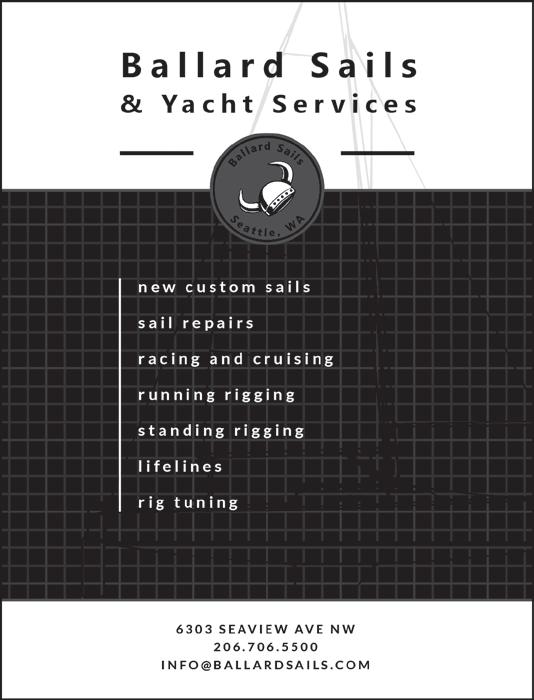



second and first in the day’s early races. Despite the solid results, we decided to switch to the #2 for the final race of the day. After a good start and first couple of legs, we prepared to wrap up the run, round the leeward mark in second, and head to the finish. A knot in the spinnaker halyard had other ideas, however. We endured a very messy rounding, and wound up finishing the race a disappointing fourth.
After two days of racing, the top four were separated by only three points. Obi Juan continued to lead the way, we were one point behind them now on Juan Solo, one further back was Chosen Juan, and It’s the Juan was now fourth but still very much still in contention. The entire regatta would hinge on two Sunday races.
Light wind greeted the fleet on Sunday. Chad, Raven, and Cameron were aboard as we looked to extend our WSCR winning streak to five years. Juan Solo, Chosen Juan, and Obi Juan all started well, but I made an ill-advised early tack away from the fleet and rounded the weather mark second behind Chosen Juan, a result that would hold to the finish. Obi Juan finished in third, tying the top three boats and setting up a winner-takes-all finale in the final race.
The fireworks started immediately in the prestart. Inside the last three minutes of the prestart I executed a double tack to kill time, but due to the light wind I was nearly stopped as I exited my second tack on starboard. Smelling blood, Chosen Juan dove to my leeward side and attempted to luff us up. I tried to avoid them, but contact occurred between my outboard and his bow. Both boats broke away and protested, and the race was on. Sailing with adrenaline, we sailed well on the beat and walked away from the fleet, maintaining a solid gap for the first three legs of the race. The final run was a different story, though, and Chosen Juan followed more pressure down the right side of the course, passing us in the final few boat-lengths of the race.
Tension was high in the yacht club as we awaited the results of the protest hearing. Nobody likes for the regatta to be decided in the protest room, but that’s where we found ourselves—the team that won the hearing would win the regatta, the other would finish third. It was a contentious but respectful hearing, and after deliberation the protest committee determined that Chosen Juan had not given me sufficient time and space to respond to him gaining right of way. We had won the regatta, and Juan Solo kept the WSCR streak alive!
It came down to the very end, but Juan Solo kept the streak
Tight racing among friends was the theme of the weekend, with three of the four fleets determining their winner in the final race. Dan Randolph and Farr 30 Nefarius took the win in PHRF 1, followed by Mike Cain’s J/105 Panic and Ben Braden’s UN30 6 Feet More. Local boats swept the podium in PHRF 2, with Chad Holcomb and Olson 25 Bigg Dogg leading the way followed by Gary Stuntz in Santana 20 Just Ducky and Larry Munns in Jeanneau 42DS Pearl JEM. Bill Weinsheimer and Islander 32-2 Excitement took home the win in the cruising class, followed by Paul Belanger’s Ericson 27 OTTER and Brian Vick’s Catalina 25 Lemonade to round out the podium.
Join us next summer for the sixth annual Whidbey Summer Classic Regatta for some more happy times under sail in Penn Cove!
Full results at: www.whidbeyclassic.com
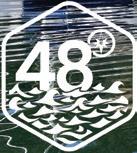
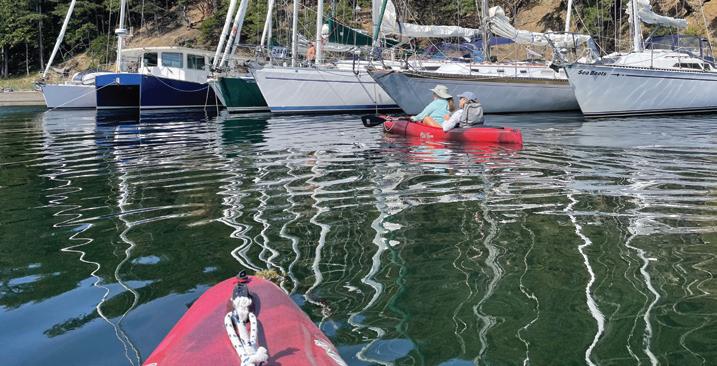

$29,500
1984 FREEDOM 32 HOYT DESIGN SLOOP
Good condition, cruise-ready. Wheel steering, autopilot, 22hp Yanmar 3GMF diesel, 3 new deep cycle batts. Carbon fiber unstayed mast, newer main/ self-tending jib, Stack Pack cover, gun mount spinnaker, Garmin radar/chartplotter, bimini, hard dodger, Force10 heater, hot/cold water, fridge/freezer, LPG stove/oven, inverter, TV/stereo, 9’ RHJ dinghy w/ 6hp Suzuki, safety gear+ » Contact George Ringstad • (425) 478-6102 • gringstad@comcast.net • $29,500
$150,000

1941 ED MONK SR. 47' CUSTOM KETCH
Recently restored custom ketch built in Seattle, WA. Very sea-kindly and easy to single hand, she has been a live-aboard her entire life. Located in Vancouver, BC, Canada in a legal, live-aboard co-operative marina. Option to purchase a share in this marina to continue living-aboard (lets you skip the 12-year waitlist!) » Contact Nancy Frosst • (604) 765-7768 • marinerboatforsale@gmail.com • $150,000
$6,000

12' KEN DOUGLAS DOUBLE ROWING/ SAILING DINGHY
Beautiful double rower/sailing dinghy in immaculate condition, as new. 12’, complete with 2 sets of spoon oars, sailing rig, sails, dagerboard, rudder, beach/ dock dolly. Built by Victoria shipwright, Ken Douglas 1996. Cedar lapstrake, white oak ribs, copper riveted. gunwales, transom, stem, etc. of African mahogany. Very tight boat, no leaks. Can deliver PNW, Puget Sound area. Currently located Vancouver » Contact Al Vittery • (604) 788-7900 • avittery@icloud.com • $6,000
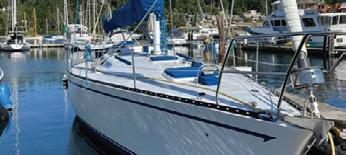
This 1982 very well maintained CONCEPT 40’ Tall Rig Sloop LOA 40’, Beam 12’8”, Draft 6’6”. 44HP Westerbeke diesel, 800 Hrs, 3 Blade Feathering Prop. Full Batten Main, Lazyjacks, 130 Genny, Spinnaker, Storm Sail. Two State Rooms, Head, Nav Station, Galley w/ Oven, Large Refer/Freezer. Lots of Storage. Radar, Autohelm. Furnace. » Contact Michael Gordon • (303) 726-3448 • mjgordon51@gmail.com • $50,000.00
$60,000

CAMPO DESIGN '81 34'x11'x6' WOOD CUTTER ABRAZO EXPEDITION YACHT 150 hrs. Beta diesel. 140 gal. diesel, 150 gal. water all stainless tankage. Fleming Globemaster vane, Skookum Canvas dodger/boom tent all chain rode, 2 8-D batteries, solar. 12 v. Fridge Freeze. Single side band, woodstove. Fir deck. » Contact Michael Nurco • (907) 738-0927 • albatrossalaskacharters@gmail.com • $60,000
$80,000

1983 COMFORT 38 MOTOR SAILER S/V MARTHA ROSE
Ketch Rig, Coastal Cruiser. Ed Monk Design, 1 Owner, 1994 6B Cummins-3700 hours, 1000 mile range, 2010 4 Blade Vari-Prop, 2021 Garmin Radar/Fish finder, Furuno Fish Finder, Ray Marine Auto Pilot, Dickinson Pacific Stove, Spectra Watermaker Ventura 150, 2 state rooms, 1 Head w/bathtub, 8 ft. Custom Skiff, Suzuki 6HP 4-stroke Outboard » Contact Dean & Kopi Carmine • skamokawapete2014@gmail.com • $80,000
1993 CATALINA 36
One owner, great condition, lots of extras. » Contact Chris Peterson • (425) 681-9910 • Chrispete308@gmail.com •$54,000
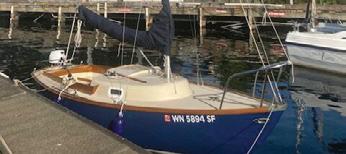
Restored 2024. New Tohatsu 6hp long shaft w/tank. Mainsail, Genoa & Spinnaker. Newly painted hull & deck. New teak trim varnished. All new Harken hardware (winches, sail tracks). Aluminum mast (25’) & spinnaker pole. Bow pulpit. New operable port lites. Cockpit & interior cushions. Anchor & line. Fenders & mooring lines. Boarding ladder. » Contact Roger H. Newell • Text: (206) 465-0375 • rhnaia@yahoo.com • $19,980 $19,980
$16,000
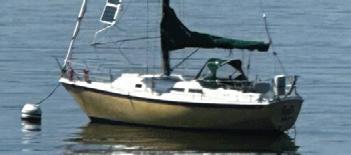
1981 28+ ERICSON
MOTOR SLOOP
Edmonds, end U dock. NEW: electric motor/controller (THOOSA 7000), 12 Dragonfly 24V 50Ah propulsion, 48V system, max prop, sails, lazy jacks, dodger, whisker pole, canvas, life lines, cushion covers, hatch, sensors, propane tank & more. 28 nm range at 4 kts. Solar panel array. Zodiac 320. New Head. Bottom Paint/zincs 8/23. » Contact Susan S. Miller • (206) 605-3433 • susansmiller@mac.com • $16,000
$9,950

An adaptation of the original Catspaw Dinghy carvel plank design to strip plank construction which consists of 1 X 1/2 inch yellow cedar strips edge-glued. The inside and outside are fiber glassed. Transom and seating are French mahogany. There is no internal frame making the interior smooth and uncluttered. » Contact David H Lester • (253) 670-3033 • dhlester@gmail.com • $9,950
$26,000

The Fales Navigator is a “stretched” version of the Willard Horizon. This boat is basically a small trawler with a sail rig attached. This boat is well-maintained and ready to cruise. It has a very reliable 4 cylinder, Perkins 4-108 diesel engine with 73 gallons of fuel tankage. It sleeps 4 comfortably and has a full galley. Includes an 8’ Livingston dinghy with a 3hp Johnson outboard. » Contact Jay Hanson • g1jayh@gmail.com • $26,000
$135,000

2003 JEANNEAU SUN ODYSSEY 40
Amazing performance cruiser for Salish Sea or offshore. Blue water vet: Mexico, Hawaii and Alaska. Excellent condition with all the gear: near new Yanmar 4JH57 (160 hrs) direct drive; aux fuel tank; MAX prop; watermaker; ESPAR hydronic heat; RADAR; AIS; power winch for main, Etc. Does it all with ease: single handed, with crew or family. Contact for full listing info. » Contact Dave Stromquist • (360) 606-9043 • dstromquist@comcast.net • $135,000


83
Volvo diesel excellent, lots of sails, needs some running rig, gauges, TLC. Tomahawk Island, Portland. Surveyed at $55k in 2020 » Contact Marvin Sannes • (503) 851-6055 • marvinsannes@msn.com • $35,000 $35,000

Lovingly cared for, maintained, and upgraded since its original construction. She has had a long career of travels, missions, and incarnations. Currently owned by a skilled and seasoned boatwright, it is time for this rare vessel to find its next adventure. She is a rare treasure in rare condition. » Contact Daniel Ellis • (360) 900-6055 • daniel@ellismarineservice.com • $45,000 $45,000

$18,000
18' HAND CRAFTED WOODEN BOAT SAINT JAYNE "BEAUTY WITH SOUL"
Handcrafted wooden boat that marries timeless elegance with seaworthy charm. Built for those who appreciate the art of classic boatbuilding. She glides like poetry across the water, turning heads at every dock. White oak frames, black locust stem and keel. Gleaming brightwork, solid keel and room for adventure. 2009 Evinrude, first used 2017, top speed is 40mph. Kept in boathouse when not in use. Lots of storage and many extras. Ideal for day cruising, fishing, lake escapes, golden hours, a stunning display piece » Contact Jayne Johnson • (360) 460-2020 • jayne.l.johnson@gmail.com • $18,000
For even more photos and listings check out 48north.com/classifieds
COOPER BANNER 32 - ANACORTES
32’ Sloop built in BC by Cooper-Banner that’s easy to single hand. Powered by reliable Volvo Penta MD7a & Saildrive. Wood stove keeps cozy interior toasty and dry on a cold PNW winter day. 300W of solar keeps the new 200Ah LiPO4 battery fully charged. Plenty of power to run the electric induction stove, fridge/freezer, and windlass. Liveaboard ready. » Contact Daniel Dyck • Text (206) 369-4660 • daniel.dyck.379ba@gmail.com • $39,000
$10,000

25’ GAFF RIGGED CUTTER S/V TULLAMORE BUILT IN PORT TOWNSEND (1997)
A William Adkin designed gaff-rigged cutter built at the NW School of Wooden Boat Building in Port Townsend circa 1997. She is 25’5” LOA, with a 7’10” beam and 3’10” draft. She carries four sails and easily sleeps three. She is powered by a low-hour 15hp Yanmar diesel with Raymarine ST2000+ auto pilot, Garmen Echomap DV with GPS and depth indicator. Needs a little TLC. In La Conner. » Contact Ross Mayberry • (206) 735-9592 • rossmayberry13@gmail.com • $10,000 OBO
$49,900

Master Mariner award winning, designed by William Starling Burgess/Stone built. Wooden hull. Roller furler. Flame totally restored in 2015. Complete survey in 2023 available. “A Sailor’s Sailboat”. Located in Richmond, CA. Classic wood racing sloop. » Contact Bob • stefroche916@gmail.com • $49,900
$98,656

Hull 15 Built Hong Kong Mahogany plank Yakal frames designed Art DeFever. Recent hull survey. Princess propane Nova Kool fridge freezer deep freeze washer dryer Espar, two heads separate shower 350 gal water 780 gal diesel 120 Lehman diesels Raymarine C140W Radar 380 W solar Victron controllers. A great little liveabourd ship with fuel efficient hull » Contact Denis • denis@deniswoodske.ca • $98,656
$322,500
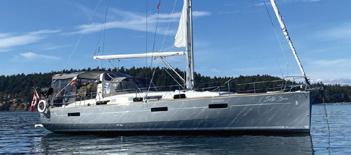
3 Cabin, 2 Heads/Showers. Fully Off-Shore Sailing equipped: Furnace Heater, Fresh Water Maker, 650W Solar, Hydrovane, Full Cockpit Enclosure, Extra water and fuel tanks, Digital Engine Gauges, Radar, Gennaker Sail, Jordan Series Drogue. Singlehanded sailing with furling main and jib, 3 Power Winches. Winter Boat Cover. Excellent Condition. » Contact Malcolm Crow • (250) 418-5196 • mpcrow1965@gmail.com • $322,500

This gorgeous Bermudian Double Ended Yawl was designed by Paul Gartside, built by Jespersen Boat Builders in B.C., Canada and launched in 2012. The Hull is cold-molded with Western Red Cedar, Douglas Fir, Fiberglass and West Systems Epoxy. The boat is beautiful, incredibly well-built and ready to sail for any horizon! View article: https://www.woodenboat.com/onlineexclusives/la-vie-en-rose » Contact (360) 316-9370 • Rob@PortTownsendBoatCo.com • $249,000 $249,000

1/3 sailboat share available in Kia Ora, a 2001 Hunter 340. Partnership has been active since 2008. Cost is $16K and $300 per month for moorage, maintenace, documentation, and insurance. » Contact lrschultz@comcast.net • $16,000


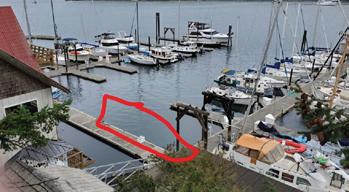
Available September 8 until June 1, on San Juan Island (Friday Harbor). Hard to find location, and great slip. Great location, just 5 minute walk from ferry terminal in Friday Harbor. Additional photos available on request. First and Last month rent required. » Contact Mark • (206) 240-6978 • scheerlaw10@gmail.com • $450/month





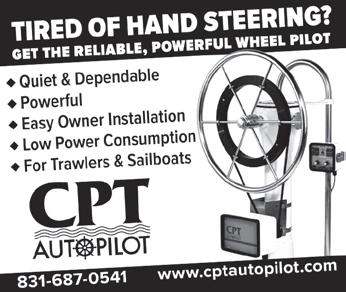



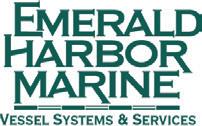





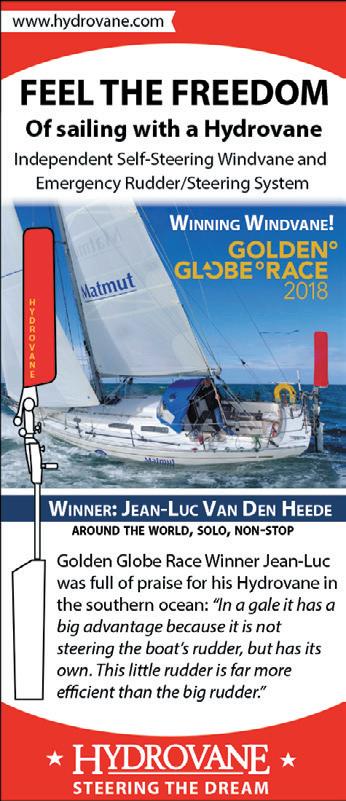

Free 2025 boat Safety Inspection and sticker presentation available now! Inspections conducted at your marina, storage site or per sign-up arrangements. Scan the QR code or search our website for details and to sign-up. Boat Safety Stickers save lives and property! Sign Up TODAY! » Contact US Coast Guard Auxiliary Flotilla 12 Edmonds • (206) 245-8662 • cgaux130fl12@outlook.com • FREE













66’ GORBON 66 ’97
$425,000
....................
“BAJAVENTO” A luxurious performance vessel that can easily be sailed shorthanded. Professionally maintained. Cruise in style and comfort.
54’ ROBERTS 54 ’79
$225,000
....................
“SPIRIT” Rugged bluewater vessel designed with comfort and safety in mind. Nicely upgraded.Coast Guard Certified for up to 42 passengers.
46’ TAYANA 460 PILOTHOUSE ’02
$315,000
.........................
“PEREGRINE”One owner boat custom-built for seller. She has sailed the South Pacific and is updated and ready for another extended cruise.


44’ KELLY PETERSON 44 ’81 $69,000 “BRAMASOLE”This well-cared for Peterson 44 with newer rigging, rebuilt engine and upgraded electronics is the quintessential cruiser.

46’ HUNTER 460 ’00 $119,500 “ALE ER RON” Versatile yacht for liveaboard, easy daysails or serious ocean passages. Reasonable offers considered.

45’ HUNTER 450 PASSAGE ’98 $105,000 “PLANB”The ultimate live-aboard cruiser. No compromise on space and comfort. Liveaboard slip possible.



37’ ISLAND PACKET 370 ’08 $229,000 “PELICAN” Extensively upgraded, fully equipped, and maintained to the highest standards. Ready to go right now!














Lyra Garcia Exploration 45 2017 • $695,000
Garcia Yachts are purpose-built for bluewater cruising in every latitude, from polar waters to tropical anchorages. Lyra, an Exploration 45, has already sailed to over 20 countries in eight years, proving her pedigree as a true go-anywhere yacht. She has been well maintained and thoughtfully equipped for serious voyaging. Designed for autonomy in remote regions, Lyra features large tankage capacity, generous storage, robust systems, and easy access to all major components. Her insulated aluminum hull, double-glazed windows, and thermal companionway door ensure comfort in the harshest climates. From the glaciers of Patagonia to shallow tropical lagoons, her retractable centerboard unlocks anchorages that are off-limits to traditional keelboats. Whether you’re chasing high latitudes or hidden islands, Lyra delivers the perfect balance of strength, safety, and comfort—ready to take you anywhere your cruising dreams lead.
– velina barnes, swiftsure yachts


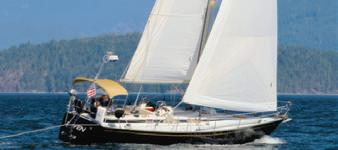

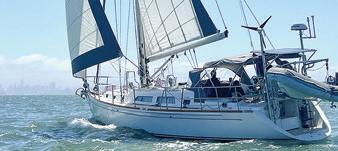


37 Beneteau Oceanis 2009 $114,000 37 Hallberg-Rassy 372 2016 $399,000 36 Hallberg-Rassy 1999 $159,000 35 Saga 2002 $99,000 36 Glacier Bay 2006 $169,000



46
46
Jeanneau 349 2022 $209,000 32 Sydney 2002 $85,000 32 Grand Banks 1982 $99,000
Hallberg-Rassy 1975 $29,000 31 Ranger Tug 2013 $239,000 29 Herreschoff Rozinante 2021 $49,500 29 Ranger Tug 2019 $235,000 26 Marieholm Folkboat 1978 $7,999
















